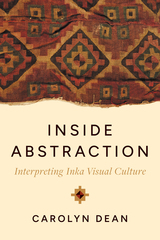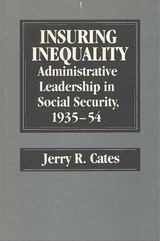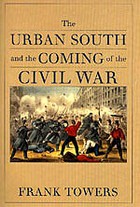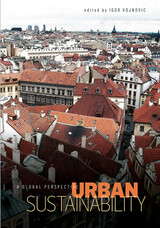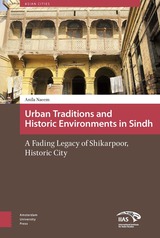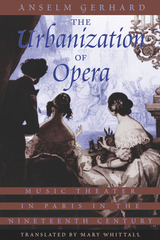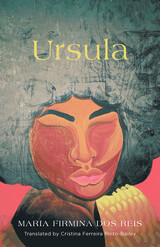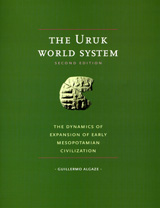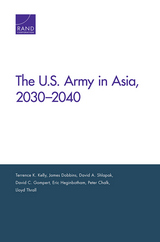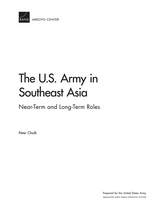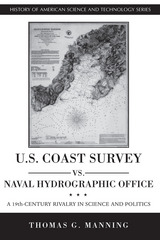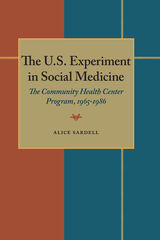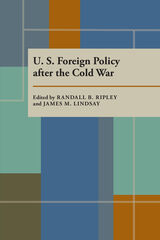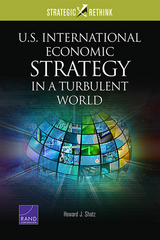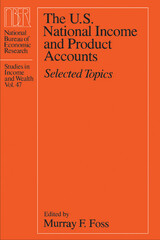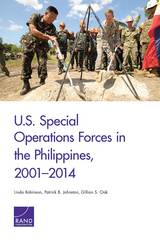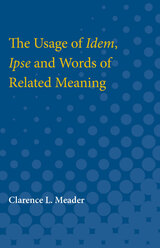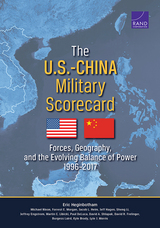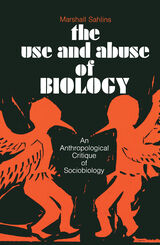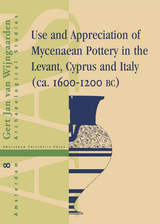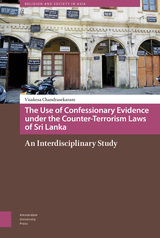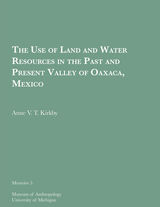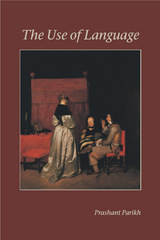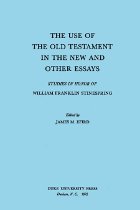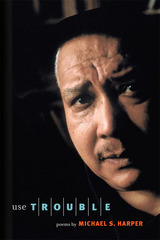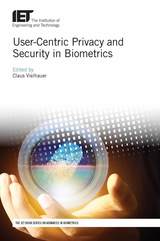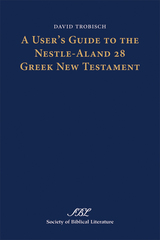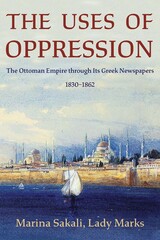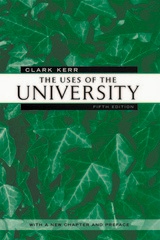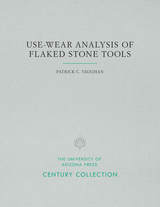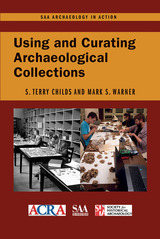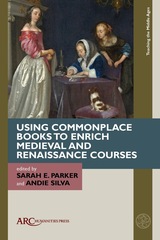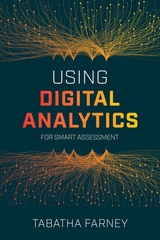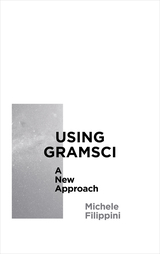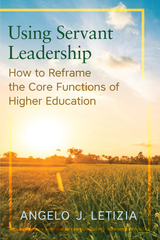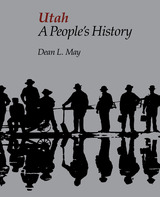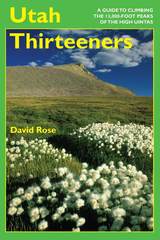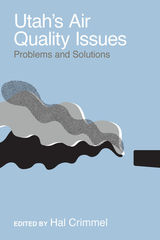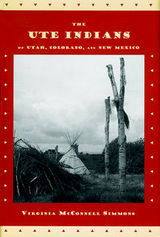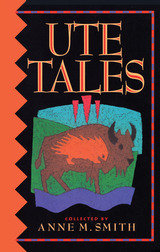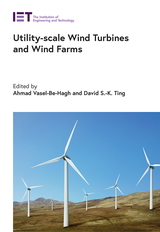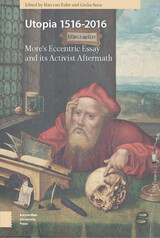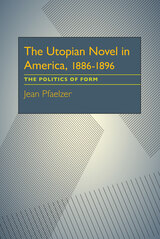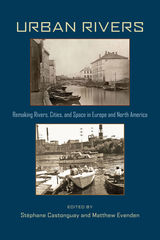 Urban Rivers: Remaking Rivers, Cities, and Space in Europe and North America
Stéphane Castonguay
University of Pittsburgh Press, 2012
Urban Rivers examines urban interventions on rivers through politics, economics, sanitation systems, technology, and societies; how rivers affected urbanization spatially, in infrastructure, territorial disputes, and in floodplains, and via their changing ecologies. Providing case studies from Vienna to Manitoba, the chapters assemble geographers and historians in a comparative survey of how cities and rivers interacted from the seventeenth century to the present.
Rising cities and industries were great agents of social and ecological changes, particularly during the nineteenth century, when mass populations and their effluents were introduced to river environments. Accumulated pollution and disease mandated the transfer of wastes away from population centers. In many cases, potable water for cities now had to be drawn from distant sites. These developments required significant infrastructural improvements, creating social conflicts over land jurisdiction and affecting the lives and livelihood of nonurban populations. The effective reach of cities extended and urban space was remade. By the mid-twentieth century, new technologies and specialists emerged to combat the effects of industrialization. Gradually, the health of urban rivers improved.
From protoindustrial fisheries, mills, and transportation networks, through industrial hydroelectric plants and sewage systems, to postindustrial reclamation and recreational use, Urban Rivers documents how Western societies dealt with the needs of mass populations while maintaining the viability of their natural resources. The lessons drawn from this study will be particularly relevant to today's emerging urban economies situated along rivers and waterways.
 Urban Saniscapes: Slums, Housing and Everyday Sanitation in Accra and Nairobi, 1908–1963
Waseem-Ahmed Bin-Kasim
Michigan State University Press, 2025 In this comparative study, Bin-Kasim examines environmental sanitation in the historical development of Accra and Nairobi, the capitals of the Gold Coast (Ghana) and Kenya. This book traces the approaches to sanitation during colonial rule and urban growth throughout the first half of the twentieth century and beyond. From the consolidation of the colonial regimes to the Great Depression, urbanization waves, and postwar development, sanitation was both a cause and a consequence of the built environment. Bin-Kasim characterizes this complex relationship between sanitation and urban growth over time as the 'saniscape.' The saniscape is the confluence of public health, planning interventions, and various urban constituencies, and includes an array of influences like colonial expertise and African industry, which shaped the two cities regardless of their power dynamics and land tenure. Attention to the saniscape validates how Africans called out colonial discrimination and inefficiencies to intervene and shape cities. This volume highlights the shared histories of Accra and Nairobi and upends conventional narratives that attach too much difference to non-settler and settler colonialism.
 Urban Screens: Situations, Practices, Concepts
Nanna Verhoeff
Amsterdam University Press, 2025 This book offers a discussion of the screens, installations, and media architecture that populate contemporary urban public spaces. It proposes a methodological approach and conceptual toolset for the critical examination, not only of what these screens do, but also of what we can do with them. The book contains a collection of theoretical concepts, developed through an in-depth examination of the material, relational, and performative aspects of a range of urban screens and screen practices. Its situational and practice-oriented approach focuses on the space between their material surfaces, the spectatorial situations they create, and how such screens situate us in relation to the surrounding social and cultural environment of the city.
Offering concepts for a critical understanding of the wide variety of contemporary urban screen practices, the book’s methodological proposal integrates close situational analyses and a historical-comparative approach for individual screens and screening situations in their role as part of a wider global contemporary screen culture.
Urban Sociology
Edited by Ernest W. Burgess and Donald J. Boque
University of Chicago Press, 1967
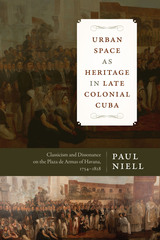 Urban Space as Heritage in Late Colonial Cuba: Classicism and Dissonance on the Plaza de Armas of Havana, 1754-1828
By Paul Niell
University of Texas Press, 2015 According to national legend, Havana, Cuba, was founded under the shade of a ceiba tree whose branches sheltered the island’s first Catholic mass and meeting of the town council (cabildo) in 1519. The founding site was first memorialized in 1754 by the erection of a baroque monument in Havana’s central Plaza de Armas, which was reconfigured in 1828 by the addition of a neoclassical work, El Templete. Viewing the transformation of the Plaza de Armas from the new perspective of heritage studies, this book investigates how late colonial Cuban society narrated Havana’s founding to valorize Spanish imperial power and used the monuments to underpin a local sense of place and cultural authenticity, civic achievement, and social order. Paul Niell analyzes how Cubans produced heritage at the site of the symbolic ceiba tree by endowing the collective urban space of the plaza with a cultural authority that used the past to validate various place identities in the present. Niell’s close examination of the extant forms of the 1754 and 1828 civic monuments, which include academic history paintings, neoclassical architecture, and idealized sculpture in tandem with period documents and printed texts, reveals a “dissonance of heritage”—in other words, a lack of agreement as to the works’ significance and use. He considers the implications of this dissonance with respect to a wide array of interests in late colonial Havana, showing how heritage as a dominant cultural discourse was used to manage and even disinherit certain sectors of the colonial population.
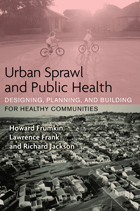 Urban Sprawl and Public Health: Designing, Planning, and Building for Healthy Communities
Howard Frumkin, Lawrence Frank, and Richard Jackson
Island Press, 2004 In Urban Sprawl and Public Health, Howard Frumkin, Lawrence Frank, and Richard Jackson, three of the nation's leading public health and urban planning experts explore an intriguing question: How does the physical environment in which we live affect our health? For decades, growth and development in our communities has been of the low-density, automobile-dependent type known as sprawl. The authors examine the direct and indirect impacts of sprawl on human health and well-being, and discuss the prospects for improving public health through alternative approaches to design, land use, and transportation. Urban Sprawl and Public Health offers a comprehensive look at the interface of urban planning, architecture, transportation, community design, and public health. It summarizes the evidence linking adverse health outcomes with sprawling development, and outlines the complex challenges of developing policy that promotes and protects public health. Anyone concerned with issues of public health, urban planning, transportation, architecture, or the environment will want to read Urban Sprawl and Public Health.
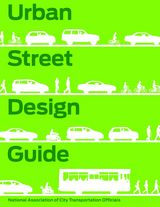 Urban Street Design Guide
National Association of City Transportation Officials
Island Press, 2013 The NACTO Urban Street Design Guide shows how streets of every size can be reimagined and reoriented to prioritize safe driving and transit, biking, walking, and public activity. Unlike older, more conservative engineering manuals, this design guide emphasizes the core principle that urban streets are public places and have a larger role to play in communities than solely being conduits for traffic.
The well-illustrated guide offers blueprints of street design from multiple perspectives, from the bird’s eye view to granular details. Case studies from around the country clearly show how to implement best practices, as well as provide guidance for customizing design applications to a city’s unique needs. Urban Street Design Guide outlines five goals and tenets of world-class street design:
• Streets are public spaces. Streets play a much larger role in the public life of cities and communities than just thoroughfares for traffic.
• Great streets are great for business. Well-designed streets generate higher revenues for businesses and higher values for homeowners.
• Design for safety. Traffic engineers can and should design streets where people walking, parking, shopping, bicycling, working, and driving can cross paths safely.
• Streets can be changed. Transportation engineers can work flexibly within the building envelope of a street. Many city streets were created in a different era and need to be reconfigured to meet new needs.
• Act now! Implement projects quickly using temporary materials to help inform public decision making.
Elaborating on these fundamental principles, the guide offers substantive direction for cities seeking to improve street design to create more inclusive, multi-modal urban environments. It is an exceptional resource for redesigning streets to serve the needs of 21st century cities, whose residents and visitors demand a variety of transportation options, safer streets, and vibrant community life.
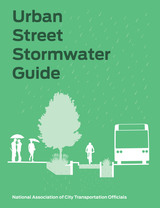 Urban Street Stormwater Guide
National Association of City Transportation Officials
Island Press, 2017 Streets make up more than 80 percent of all public space in cities, yet street space is often underutilized or disproportionately allocated to the movement of private motor vehicles. Excess impervious surface contributes to stormwater runoff, posing a threat to the environment and human health, and often overwhelming sewer systems. This excess asphalt also poses a threat to public safety, encouraging faster speeds and dangerous conditions for people walking and biking.
The Urban Street Stormwater Guide begins from the principle that street design can support—or degrade—the urban area’s overall environmental health. By incorporating Green Stormwater Infrastructure (GSI) into the right-of-way, cities can manage stormwater and reap the public health, environmental, and aesthetic benefits of street trees, planters, and greenery in the public realm. With thoughtful design, GSI can bolster strategies to provide a safe and pleasant walking and biking experience, efficient and reliable transit service, and safer streets for all users.
Building on the successful NACTO urban street guides, the Urban Street Stormwater Guide provides the best practices for the design of GSI along transportation corridors. The authors consider context-sensitive design elements related to street design, character and use, zoning, posted speed, traffic volumes, and impacts to non-motorized and vehicular access. The Guide documents and synthesizes current practices being developed by individual agencies and recommends design guidance for implementation, as well as explores innovative new strategies being tested in cities nationwide. The guidance will focus on providing safe, functioning and maintainable infrastructure that meets the unique needs and requirements of the transportation corridors and its various uses and users.
The state-of-the-art solutions in this guide will assist urban planners and designers, transportation engineers, city officials, ecologists, public works officials, and others interested in the role of the built urban landscape in protecting the climate, water quality, and natural environment.
Urban Sustainability: A Global Perspective
Igor Vojnovic
Michigan State University Press, 2012 More than half the world’s population currently lives in urban areas, and virtually all of the world’s population growth over the next three decades is expected to be in cities. What impact will this growth have on the environment? What can we do now to pave the way for resource longevity? Sustainability has received considerable attention in recent years, though conceptions of the term remain vague. Using a wide array of cities around the globe as case studies, this timely book explores the varying nature of global urban-environmental stresses and the complexities involved in defining sustainability policies. Working with six core themes, the editor examines the past, present, and future of urban sustainability within local, national, and global contexts.
Urban Traditions and Historic Environments in Sindh: A Fading Legacy of Shikarpoor, Historic City
Anila Naeem
Amsterdam University Press, 2017 Shikarpoor Historic City, in Sindh, Pakistan, has a rich historical heritage: as a central point on caravan trade routes, it served as the gateway to Afghanistan and Central Asia. In recognition of that history, in 1998 the government of Sindh named it a protected heritage site-but that status hasn't prevented the ongoing destruction of the city's historic fabric. This book tells the story of Shikarpoor and presents as complete a picture of its threatened historical fabric as possible, through copious maps and images past and present.
Urban Traffic Analysis and Control: The key challenges in the era of ITS
Roberta Di Pace
The Institution of Engineering and Technology, 2025 Urban Traffic Analysis and Control: The key challenges in the era of ITS explores urban traffic control strategies. It provides a comprehensive overview of traffic management methods, focusing on both static and dynamic applications. The book addresses issues related to transportation planning, or simpler cases where real-time adaptive control is not necessary, as well as traffic control applications based on real-time monitoring and dynamic models or data-driven methods for flow prediction.
 Urban Transformation: Understanding City Form and Design
Peter Bosselmann
Island Press, 2008 How do cities transform over time? And why do some cities change for the better while others deteriorate? In articulating new ways of viewing urban areas and how they develop over time, Peter Bosselmann offers a stimulating guidebook for students and professionals engaged in urban design, planning, and architecture. By looking through Bosselmann’s eyes (aided by his analysis of numerous color photos and illustrations) readers will learn to “see” cities anew.
Bosselmann organizes the book around seven “activities”: comparing, observing, transforming, measuring, defining, modeling, and interpreting. He introduces readers to his way of seeing by comparing satellite-produced “maps” of the world’s twenty largest cities. With Bosselmann’s guidance, we begin to understand the key elements of urban design. Using Copenhagen, Denmark, as an example, he teaches us to observe without prejudice or bias.
He demonstrates how cities transform by introducing the idea of “urban morphology” through an examination of more than a century of transformations in downtown Oakland, California. We learn how to measure quality-of-life parameters that are often considered immeasurable, including “vitality,” “livability,” and “belonging.” Utilizing the street grids of San Francisco as examples, Bosselmann explains how to define urban spaces. Modeling, he reveals, is not so much about creating models as it is about bringing others into public, democratic discussions. Finally, we find out how to interpret essential aspects of “life and place” by evaluating aerial images of the San Francisco Bay Area taken in 1962 and those taken forty-three years later.
Bosselmann has a unique understanding of cities and how they “work.” His hope is that, with the fresh vision he offers, readers will be empowered to offer inventive new solutions to familiar urban problems.
Urban Transformations in Sierra Leone: Knowledge Co-Production and Partnerships for a Just City
Edited by Joseph M. Macarthy, Braima Koroma, Andrea Rigon, Alexandre Apsan Frediani, and Andrea Klingel
University College London, 2024 Brings together research from different sectors that offers a significant contribution to knowledge on Freetown, Sierra Leone, and demonstrates the potential of transdisciplinary work.
With a population of over one million, Freetown, Sierra Leone faces serious challenges with service provisions, housing, infrastructure, employment, and climate change. In 2015, the Sierra Leone Urban Research Centre (SLURC) was established to address these challenges through research, capacity building, and advocacy. Urban Transformations in Sierra Leone shares SLURC’s progress, articulating its key findings and reflections on the partnerships it helped enable.
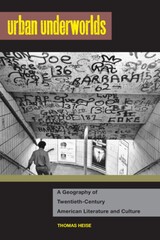 Urban Underworlds: A Geography of Twentieth-Century American Literature and Culture
Heise, Thomas
Rutgers University Press, 2010 Urban Underworlds is an exploration of city spaces, pathologized identities, lurid fears, and American literature. Surveying the 1890s to the 1990s, Thomas Heise chronicles how and why marginalized populations immigrant Americans in the Lower East Side, gays and lesbians in Greenwich Village and downtown Los Angeles, the black underclass in Harlem and Chicago, and the new urban poor dispersed across American cities have been selectively targeted as "urban underworlds" and their neighborhoods characterized as miasmas of disease and moral ruin.
The quarantining of minority cultures helped to promote white, middle-class privilege. Following a diverse array of literary figures who differ with the assessment of the underworld as the space of the monstrous Other, Heise contends that it is a place where besieged and neglected communities are actively trying to take possession of their own neighborhoods.
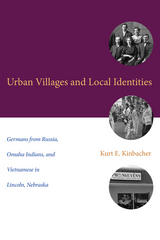 Urban Villages and Local Identities: Germans from Russia, Omaha Indians, and Vietnamese in Lincoln, Nebraska
Kurt E. Kinbacher
Texas Tech University Press, 2015 Urban Villages and Local Identities examines immigration to the Great Plains by surveying the experiences of three divergent ethnic groups—Volga Germans, Omaha Indians, and Vietnamese—that settled in enclaves in Lincoln, Nebraska, beginning in 1876, 1941, and 1975, respectively. These urban villages served as safe havens that protected new arrivals from a mainstream that often eschewed unfamiliar cultural practices.
Lincoln’s large Volga German population was last fully discussed in 1918; Omahas are rarely studied as urban people although sixy-five percent of their population lives in cities; and the growing body of work on Vietnamese tends to be conducted by social scientists rather than historians, few of whom contrast Southeast Asian experiences with those of earlier waves of immigration.
As a comparative study, Urban Villages and Local Identities is inspired, in part, by Reinventing Free Labor, by Gunther Peck. By focusing on the experiences of three populations over the course of 130 years, Urban Villages connects two distinct eras of international border crossing and broadens the field of immigration to include Native Americans. Ultimately, the work yields insights into the complexity, flexibility, and durability of cultural identities
among ethnic groups and the urban mainstream in one capital city.
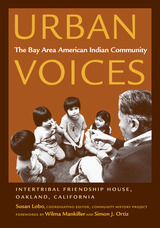 Urban Voices: The Bay Area American Indian Community
Susan Lobo, Coordinating Editor, Community History Project; Forewords by Wilma Mankiller and Simon J. Ortiz
University of Arizona Press, 2002 California has always been America's promised land—for American Indians as much as anyone. In the 1950s, Native people from all over the United States moved to the San Francisco Bay Area as part of the Bureau of Indian Affairs Relocation Program. Oakland was a major destination of this program, and once there, Indian people arriving from rural and reservation areas had to adjust to urban living. They did it by creating a cooperative, multi-tribal community—not a geographic community, but rather a network of people linked by shared experiences and understandings. The Intertribal Friendship House in Oakland became a sanctuary during times of upheaval in people's lives and the heart of a vibrant American Indian community. As one long-time resident observes, "The Wednesday Night Dinner at the Friendship House was a must if you wanted to know what was happening among Native people." One of the oldest urban Indian organizations in the country, it continues to serve as a gathering place for newcomers as well as for the descendants of families who arrived half a century ago. This album of essays, photographs, stories, and art chronicles some of the people and events that have played—and continue to play—a role in the lives of Native families in the Bay Area Indian community over the past seventy years. Based on years of work by more than ninety individuals who have participated in the Bay Area Indian community and assembled by the Community History Project at the Intertribal Friendship House, it traces the community's changes from before and during the relocation period through the building of community institutions. It then offers insight into American Indian activism of the 1960s and '70s—including the occupation of Alcatraz—and shows how the Indian community continues to be created and re-created for future generations. Together, these perspectives weave a richly textured portrait that offers an extraordinary inside view of American Indian urban life. Through oral histories, written pieces prepared especially for this book, graphic images, and even news clippings, Urban Voices collects a bundle of memories that hold deep and rich meaning for those who are a part of the Bay Area Indian community—accounts that will be familiar to Indian people living in cities throughout the United States. And through this collection, non-Indians can gain a better understanding of Indian people in America today. "If anything this book is expressive of, it is the insistence that Native people will be who they are as Indians living in urban communities, Natives thriving as cultural people strong in Indian ethnicity, and Natives helping each other socially, spiritually, economically, and politically no matter what. I lived in the Bay Area in 1975-79 and 1986-87, and I was always struck by the Native (many people do say 'American Indian' emphatically!) community and its cultural identity that has always insisted on being second to none. Yes, indeed this book is a dynamic, living document and tribute to the Oakland Indian community as well as to the Bay Area Indian community as a whole." —Simon J. Ortiz "When my family arrived in San Francisco in 1957, the people at the original San Francisco Indian Center helped us adjust to urban living. Many years later, I moved to Oakland and the Intertribal Friendship House became my sanctuary during a tumultuous time in my life. The Intertribal Friendship House was more than an organization. It was the heart of a vibrant tribal community. When we returned to our Oklahoma homelands twenty years later, we took incredible memories of the many people in the Bay Area who helped shape our values and beliefs, some of whom are included in this book." —Wilma Mankiller, former Principal Chief, Cherokee Nation
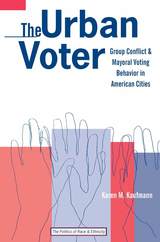 The Urban Voter: Group Conflict and Mayoral Voting Behavior in American Cities
Karen M. Kaufmann
University of Michigan Press, 2004
Karen Kaufmann's groundbreaking study shows that perceptions of interracial conflict can cause voters in local elections to focus on race, rather than party attachments or political ideologies. Using public opinion data to examine mayoral elections in New York and Los Angeles over the past 35 years, Kaufmann develops a contextual theory of local voting behavior that accounts for the Republican victories of the 1990s in these overwhelmingly Democratic cities and the "liberal revivals" that followed. Her conclusions cast new light on the interactions between government institutions, local economies, and social diversity. The Urban Voter offers a critical analysis of urban America's changing demographics and the ramifications of these changes for the future of American politics.
This book will interest scholars and students of urban politics, racial politics, and voting behavior; the author's interdisciplinary approach also incorporates theoretical insights from sociology and social psychology. The Urban Voter is appropriate for both undergraduate and graduate level courses.
Karen Kaufmann is Assistant Professor in the Department of Government and Politics at the University of Maryland, College Park.
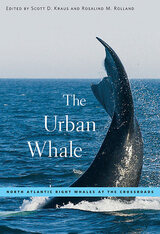 The Urban Whale: North Atlantic Right Whales at the Crossroads
Scott D. Kraus
Harvard University Press, 2010 In 1980 a group of scientists censusing marine mammals in the Bay of Fundy was astonished at the sight of 25 right whales. It was, one scientist later recalled, “like finding a brontosaurus in the backyard.” Until that time, scientists believed the North Atlantic right whale was extinct or nearly so. The sightings electrified the research community, spurring a quarter century of exploration, which is documented here.
The authors present our current knowledge about the biology and plight of right whales, including their reproduction, feeding, genetics, and endocrinology, as well as fatal run-ins with ships and fishing gear. Employing individual identifications, acoustics, and population models, Scott Kraus, Rosalind Rolland, and their colleagues present a vivid history of this animal, from a once commercially hunted commodity to today’s life-threatening challenges of urban waters.
Hunted for nearly a millennium, right whales are now being killed by the ocean commerce that supports our modern way of life. This book offers hope for the eventual salvation of this great whale.
 Urban Wildlife Habitats: A Landscape Perspective
Lowell W. Adams
University of Minnesota Press, 1994 Urban Wildlife Habitats was first published in 1994. Minnesota Archive Editions uses digital technology to make long-unavailable books once again accessible, and are published unaltered from the original University of Minnesota Press editions. In cities, towns, and villages, between buildings and parking lots, streets and sidewalks, and polluted streams and rivers, there is ever less space for the "natural," the plants and animals that once were at home across North America. In this first book-length study of the subject, Lowell W. Adams reviews the impact of urban and suburban growth on natural plant and animal communities and reveals how, with appropriate landscape planning and urban development, cities and towns can be made more accommodating for a wide diversity of species, including our own. Soils and ground surface, air, water, and noise pollution, space and demographics are among the urban characteristics Adams considers in relation to wildlife. He describes changes in the composition and structure of vegetation, as native species are replaced by exotic ones, and shows how, with spreading urbanization of natural habitats, the diversity of species of plants and animals almost always declines, although the density of a few species increases. Adams contends, however, that it is possible for a wide variety of species to coexist in the metropolitan environment, and he cites a growing interest in the practice of "natural landscaping," which emphasizes the use of native species and considers the structure, pattern, and species composition of vegetation as it relates to wildlife needs. Urban habitats vary from small city parks in densely built downtowns to suburbs with large yards and considerable open space. Adams discusses the opportunities these areas—along with school yards, hospital grounds, cemeteries, individual residences, and vacant lots—provide for judicious wildlife management and for the salutary interaction of people with nature. Lowell W. Adams is vice president of the National Institute for Urban Wildlife in Columbia, Maryland.
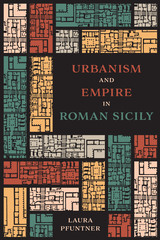 Urbanism and Empire in Roman Sicily
By Laura Pfuntner
University of Texas Press, 2019 Sicily has been the fulcrum of the Mediterranean throughout history. The island’s central geographical position and its status as ancient Rome’s first overseas province make it key to understanding the development of the Roman Empire. Yet Sicily’s crucial role in the empire has been largely overlooked by scholars of classical antiquity, apart from a small number of specialists in its archaeology and material culture. Urbanism and Empire in Roman Sicily offers the first comprehensive English-language overview of the history and archaeology of Roman Sicily since R. J. A. Wilson’s Sicily under the Roman Empire (1990). Laura Pfuntner traces the development of cities and settlement networks in Sicily in order to understand the island’s political, economic, social, and cultural role in Rome’s evolving Mediterranean hegemony. She identifies and examines three main processes traceable in the archaeological record of settlement in Roman Sicily: urban disintegration, urban adaptation, and the development of alternatives to urban settlement. By expanding the scope of research on Roman Sicily beyond the bounds of the island itself, through comparative analysis of the settlement landscapes of Greece and southern Italy, and by utilizing exciting evidence from recent excavations and surveys, Pfuntner establishes a new empirical foundation for research on Roman Sicily and demonstrates the necessity of including Sicily in broader historical and archaeological studies of the Roman Empire.
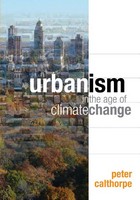 Urbanism in the Age of Climate Change
Peter Calthorpe
Island Press, 2010 “Cities are green” is becoming a common refrain. But Calthorpe argues that a more comprehensive understanding of urbanism at the regional scale provides a better platform to address climate change. In this groundbreaking new work, he shows how such regionally scaled urbanism can be combined with green technology to achieve not only needed reductions in carbon emissions but other critical economies and lifestyle benefits. Rather than just providing another checklist of new energy sources or one dimensional land use alternatives, he combines them into comprehensive national growth scenarios for 2050 and documents their potential impacts. In so doing he powerfully demonstrates that it will take an integrated approach of land use transformation, policy changes, and innovative technology to transition to a low carbon economy.
To accomplish this Calthorpe synthesizes thirty years of experience, starting with his ground breaking work in sustainable community design in the 1980s following through to his current leadership in transit-oriented design, regional planning, and land use policy. Peter Calthorpe shows us what is possible using real world examples of innovative design strategies and forward-thinking policies that are already changing the way we live.
This provocative and engaging work emerges from Calthorpe’s belief that, just as the last fifty years produced massive changes in our culture, economy and environment, the next fifty will generate changes of an even more profound nature. The book, enhanced by its superb four-color graphics, is a call to action and a road map for moving forward.
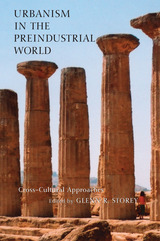 Urbanism in the Preindustrial World: Cross-Cultural Approaches
Edited by Glenn R. Storey
University of Alabama Press, 2006 A baseline study of the growth of preindustrial cities worldwide.
This work employs a subset of preindustrial cities on many continents to answer questions archaeologists grapple with concerning the populating and growth of cities before industrialization. It further explores how scholars differently conceive and execute their research on the population of cities. The subject cities are in Greece, Mesoamerica, the Andes, Italy, Egypt, Africa, United States, Denmark, and China. This broad sample provides a useful framework for answers to such questions as “Why did people agglomerate into cities?” and “What population size and what age of endurance constitute a city?”
The study covers more than population magnitude and population makeup, the two major frameworks of urban demography. The contributors combine their archaeological and historical expertise to reveal commonalities, as well as theoretical extrapolations and methodological approaches, at work here and outside the sample.
Urbanism in the Preindustrial World is a unique study revealing the variety of factors involved in the coalescing and dispersal of populations in preindustrial times.
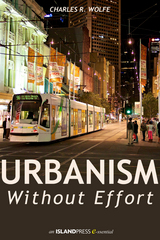 Urbanism Without Effort
Charles R. Wolfe
Island Press, 2013 **Revised editions (paperback and e-book) to be released at beginning of 2019; available for preorder now on separate product page.
This product is part of the Island Press E-ssentials Series and is not the most current edition.**
This beautifully illustrated short e-book explores the idea that to create vibrant, sustainable urban areas for the long term, we must first understand what happens naturally when people congregate in cities—innate, unprompted interactions of urban dwellers with each other and their surrounding urban and physical environment. Wolfe elaborates on the perspective that the underlying rationales for urban policy, planning and regulation are best understood from a historical perspective and in a better understanding of the everyday uses of urban space. To make his case, Wolfe draws on his years of writing about urbanism as well as his professional experiences as a land use and environmental lawyer and offers compelling case study vignettes from everyday urban life.
Successful community, Wolfe argues, is among the first principles of what makes humans feel happy, and therefore city dwellers invariably celebrate environments where and when they can coexist safely, in a mutually supportive way. Wolfe believes such celebration is most interesting when it occurs spontaneously—seemingly without effort. He contends it is critical to first isolate these spontaneous and latent examples of successful urban land use, before applying any prescriptive government policies or initiatives. Wolfe provides something rare in contemporary urbanist writing—rich illustrations and examples from real life—both historical and current. His writing about the past and the future of urban form offers readers inspiration, historical context, and a better understanding of how a sustainable, inviting urban environment is created.
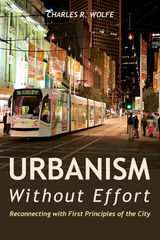 Urbanism Without Effort: Reconnecting with First Principles of the City
Charles R. Wolfe
Island Press, 2018 How do you create inviting and authentic urban environments where people feel at home? Countless community engagement workshops, studies by consulting firms, and downtown revitalization campaigns have attempted to answer this age-old question. In Urbanism Without Effort, Chuck Wolfe argues that “unplanned” places can often teach us more about great placemaking than planned ones.
From impromptu movie nights in a Seattle alley to the adapted reuse of Diocletian’s Palace in Split, Croatia, Wolfe searches for the “first principles” of what makes humans feel happy and safe amid the hustle and bustle of urban life. He highlights the common elements of cities around the world that spontaneously bring people together: being inherently walkable, factors that contribute to safety at night, the importance of intersections and corners, and more. In this age of skyrocketing metropolitan growth, he argues, looking to the past might be our best approach to creating the urban future we dream about.
A whirlwind global tour, Urbanism Without Effort offers readers inspiration, historical context, and a better understanding of how an inviting urban environment is created.
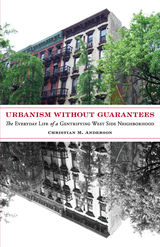 Urbanism without Guarantees: The Everyday Life of a Gentrifying West Side Neighborhood
Christian M. Anderson
University of Minnesota Press, 2020 A unique more-than-capitalist take on urban dynamics
Vigilante action. Renegades. Human intrigue and the future at stake in New York City. In Urbanism without Guarantees, Christian M. Anderson offers a new perspective on urban dynamics and urban structural inequality based on an intimate ethnography of on-the-ground gentrification. The book is centered on ethnographic work undertaken on a single street in Clinton/Hell’s Kitchen in New York City—once a site of disinvestment, but now rapidly gentrifying. Anderson examines the everyday strategies of residents to preserve the quality of life of their neighborhood and to define and maintain their values of urban living—from picking up litter and reporting minor concerns on the 311 hotline to hiring a private security firm to monitor the local public park. Anderson demonstrates how processes such as investment and gentrification are constructed out of the collective actions of ordinary people, and challenges prevalent understandings of how place-based civic actions connect with dominant forms of political economy and repressive governance in urban space. Examining how residents are pulled into these systems of gentrification, Anderson proposes new ways to think and act critically and organize for transformation of a place—in actions that local residents can start to do wherever they are.
Urbanization and Urban Problems
Edwin S. Mills and Byung-Nak Song
Harvard University Press, 1979 Focusing on the period since World War II, this work investigates urban growth, its effects on patterns of activity within and among Korean cities, and its effects on urban life. Included are a survey of migration within the country, between South and North Korea, and between Korea and Japan, and a detailed analysis of changes in the spatial patterns of Korean cities, showing the rapid decentralization during recent years.
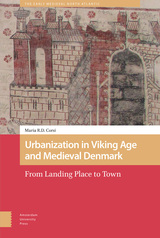 Urbanization in Viking Age and Medieval Denmark: From Landing Place to Town
Maria Corsi
Amsterdam University Press, 2020 This study traces the history of urbanization in Denmark from c. 500 to 1350 and explores how interconnected political, religious, and economic factors were instrumental in bringing about the growth of towns. Prior to urban development, certain specialized sites such as elite residences and coastal landing places performed many of the functions that would later be taken over by medieval towns. Fundamental changes in political power, the coming of Christianity, and economic development over the course of the Viking and Middle Ages led to the abandonment of these sites in favour of new urban settlements that would come to form the political, religious, and economic centres of the medieval kingdom. Bringing together both archaeological and historical sources, this study illustrates not only how certain cultural and economic shifts were crucial to the development of towns, but also the important role urbanization had in the transition from Viking to medieval Denmark.
The Urbanization of Opera: Music Theater in Paris in the Nineteenth Century
Anselm Gerhard
University of Chicago Press, 1998 Anselm Gerhard explores the origins of grand opéra, arguing that its aesthetic innovations (both musical and theatrical) reflected not bourgeois tastes, but changes in daily life and psychological outlook produced by the rapid urbanization of Paris. These larger urban and social concerns—crucial to our understanding of nineteenth-century opera—are brought to bear in fascinating discussions of eight operas composed by Rossini, Auber, Meyerbeer, Verdi, and Louise Bertin.
"An invaluable look at this fascinating genre."—George W. Loomis, Opera News
 Urbanizing China in War and Peace: The Case of Wuxi County
Toby Lincoln
University of Hawaii Press, 2015 Urbanizing China in War and Peace argues that urbanization is a total societal transformation and as important a factor as revolution, nationalism, or modernity in the history of modern China. China’s urbanization was not only driven by industrial capitalism and the expansion of the state, but also shaped how these forces influenced daily life in the city and the countryside. Although the conflict that beset China after the Japanese invasion in 1937 affected the development of cities, towns, and villages, it did not derail previous changes. To truly understand how China has emerged as the world’s largest urban society, we must consider such continuities across the first half of the twentieth century— during periods of war as well as peace. The book focuses on Wuxi, a city that lies a hundred miles to the west of Shanghai. In the early twentieth century local industrialists were responsible for it quickly becoming the largest industrial city in China outside treaty ports. They built factories, roads, and other infrastructure outside the old city walls and in surrounding towns and villages. Chapters examine the county’s transformation as recorded in guidebooks and travel magazines of the time and the role of the state in the early 1920s and into the Nanjing Decade, when new administrative laws led to the continued expansion of the city under both municipal and county officials. They explore the revival of the silk industry during the Japanese occupation and the industry’s role in driving urbanization, as well as efforts by Chinese leaders to carry out prewar development plans despite lockdowns and qingxiang (clean the countryside) campaigns. In the midst of the barbed wire and watch towers, plans to shape the built environment in Wuxi County and the region as a whole persisted and were carried out. Ambitious and well researched, Urbanizing China in War and Peace will appeal to scholars and students of Chinese urban history, the Anti-Japanese War of Resistance, and the Republican period.
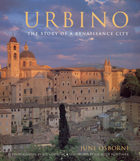 Urbino: The Story of a Renaissance City
June Osborne
University of Chicago Press, 2003 During the Renaissance, the Italian city of Urbino rivaled Florence and Siena as a center of art, culture, and commerce. Chances are you've never heard of it—but you should have. Raphael was born there. Piero della Francesca painted his famous The Flagellation there. And the city's exquisite Ducal Palace, its twin towers piercing the sky, remains a striking monument to grace and power. Yet despite all its past glory and present charm, Urbino is practically unknown to tourists today.
With Urbino: The Story of a Renaissance City, art historian June Osborne brings to life not only the great city and its art but also its turbulent history and the intrigue surrounding its ruling family. First settled by the ancient Umbrians, Urbino reached its zenith during the fifteenth century under the rule of Duke Federico da Montefeltro and his son Guidobaldo. Federico may have been a usurper and a fierce, opportunistic warlord, but his lust for power was more than matched by his passion for great art. Indeed it was under his direct guidance that the magnificent Ducal Palace was built—its perfectly proportioned courtyard a wonder of early Renaissance architecture.
Today the Ducal Palace hosts the National Gallery of the Marches, one of the most important art galleries in Italy, featuring works by no lesser lights than Raphael, Uccello, Piero della Francesca, and Titian. Exploring such sites as the fourteenth-century Oratorio di San Giovanni Battista and the Gothic Church of San Domenico, Osborne captures not only the startling beauty of Urbino and the Apennine foothills but also the tumultuous legacy of Frederico and his son (and their many wives and courtiers).
With over a hundred lavish color photographs, many by renowned landscape photographer Joe Cornish, Urbino is the best—and the only—guide to this gem of the Italian Marches.
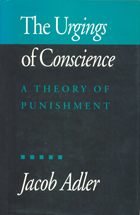 The Urgings of Conscience: A Theory of Punishment
Jacob Adler
Temple University Press, 1992 While most philosophers who write about punishment ask, "Why may we punish the guilty?" Jacob Adler asks, "To what extent does a guilty person have a duty to submit to punishment?" He maintains that if we are to justify any system of punishment by the state, we must explain why persons guilty of an offense are morally bound to submit to punitive treatment, or to undertake it on their own. Using Rawls's theory of social contract as a framework, the author presents what he calls the rectification theory of punishment. After examining punishment from two points of view—that of the punisher and that of the offender who is to be punished—Adler proposes the Paradigm of the Conscientious Punishee: a repentant wrongdoer who views punishment as not necessarily unpleasant, but as something it is morally incumbent upon one to undertake. The author argues that this paradigm must play a central role in the theory of punishment. Citing community service projects and penances for sin (as required by some religions), Adler argues that punishment need not involve pain or any other disvalue. Instead he defines it in terms of its justificatiory connection with wrongdoing: punishment is that which is justified by the prior commission of an offense and generally not justified without the prior commission of an offense. The rectification theory applies particularly to offenses involving basic liberties. It is based on the assumption that each person is guaranteed the right to an inviolable sphere of liberty. Someone who commits an offense has expanded his or her sphere by arrogating excess liberties. In order to maintain the equality on which this theory rests, an equivalent body of liberties must be given up. In discussing applications of the theory, Adler demonstrates that active service (as punishment) is more effective in safeguarding important rights and interests and maintaining the social contract than is afflictive punishment.
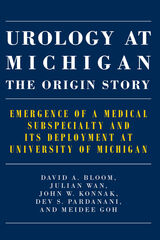 Urology at Michigan: The Origin Story: Emergence of a Medical Subspecialty and Its Deployment at University of Michigan
David A. Bloom
Michigan Publishing, 2021 This book describes the emergence of a small but essential medical specialty, urology, at one of the first American public institutions of higher education, the University of Michigan. Urology at Michigan: The Origin Story, a microcosm of the modern world of healthcare specialization, entwines many stories beginning with its earliest roots, diagnostic uroscopy and the primitive interventions of catheterization and lithotomy. The Hippocratic Oath forbade its generalist healers from only three practices – abortion, euthanasia, and lithotomy, relegating the last to specialists “in that art,” namely itinerant lithotomists of whom little record remains. Over two and a half millennia since Hippocrates, catheterization, lithotomy, and genitourinary surgery in general advanced only modestly until products of the industrial revolution and scientific inquiry provided the tools and knowledge that accelerated the ancient genitourinary work into a new discipline of urology around the fin de siècle of the 19th century, just as the University of Michigan concurrently was joining the top rank of higher education. The University of Michigan in the early 20th century was nearly a century old and contained a medical school and wholly-owned University Hospital, the first of that genre. Ann Arbor was a propitious place for modern urology to take hold when Hugh Cabot brought not just the new terminology, but also the complete triple mission with urologic education and research embedded in a milieu of world-class clinical care. Cabot arrived in Ann Arbor from Boston in the autumn of 1919, imbued with more than two years’ service in WWI with the British Expeditionary Forces on the Western Front, and he became Dean of the Medical School in 1921. Cabot expanded the full-time salary model in the medical school, supervised construction of Ann Arbor’s 4th iteration of the University Hospital, but its first state-of the art facility. He created a multi-specialty academic group practice and assembled a great faculty with future leaders in surgery including Frederick Coller, Max Peet, Carl Badgley, and John Alexander. Cabot’s first trainees to become urologists were Charles Huggins, a future Nobel Laureate, and Reed Nesbit who rose to the top ranks of academic and organizational urology and made Ann Arbor an international clinical and educational destination. This book tells the story of urology at Michigan amidst the larger stories of the roots of genitourinary surgery, the formation of the University of Michigan and its Medical School, and the inevitable tensions of balancing the triple mission of medical academia: education and investigation within a milieu of the essential transaction of excellent clinical care.
Ursula
Maria Firmina dos Reis, Translated by Cristina Ferreira Pinto-Bailey
Tagus Press, 2021 Written within the literary conventions of the Romantic movement and published decades before other Brazilian abolitionist novels, Ursula (1859) offers a sensitive and nuanced portrayal of enslaved African and Afro-Brazilian characters. While readers follow the story of the plantation owner's daughter Ursula, her doomed romance with Tancredo, and her uncle's diabolical schemes to entrap her in marriage, the novel's power lies in Reis's characterization of the enslaved Africans Tulio, Susana, and Antero. Shown in all their humanity as they narrate their personal histories and give voice to the abuse and injustices they have endured, these characters tell of the horrors of the Middle Passage, the daily indignities they face, and the brutality of their masters.
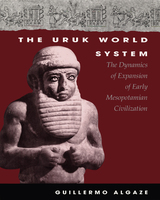 The Uruk World System: The Dynamics of Expansion of Early Mesopotamian Civilization
Guillermo Algaze
University of Chicago Press, 1993 Archaeologists and historians have long been keenly interested in the emergence of early cities and states in the ancient Near East, particularly in the growth of early Sumerian civilization in the lowlands of Mesopotamia during the second half of the fourth millennium B.C. Most scholars have focused on the internal transformations attending this process, such as the development of new forms of spatial organization, socio-political relationships, and economic arrangements.
In The Uruk World System, Guillermo Algaze concentrates instead on the unprecedented and wide-ranging process of external expansion that coincided with the rapid initial crystallization of Mesopotamian civilization. He contends that the rise of early Sumerian polities cannot be understood without also taking into account developments in surrounding peripheral areas.
Algaze reviews an extensive body of archaeological evidence for cross-cultural exchange between the nascent city-states in the Mesopotamian lowlands and communities in immediately surrounding areas. He shows that at their very inception the more highly integrated lowland centers succeeded in establishing a variety of isolated, far-flung outposts in areas at the periphery of the Mesopotamian lowlands. Embedded in an alien hinterland characterized by demonstrably less complex societies, the outposts were commonly established at the apex of preexisting regional settlement hierarchies and invariably at focal nodes astride important trade routes. Algaze argues that these early colonial out-posts served as collection points for coveted peripheral resources acquired in exchange for core manufactures and that they reflect an inherently asymmetrical system of economic hegemony that extended far beyond areas under the direct political control of Sumerian polities in southern Mesopotamia. From this he concludes that economic exploitation of less developed peripheral areas was integral to the earliest development of civilization in the ancient Near East.
The Uruk World System: The Dynamics of Expansion of Early Mesopotamian Civilization, Second Edition
Guillermo Algaze
University of Chicago Press, 2005 Most archaeologists and historians of the ancient Near East have focused on the internal transformations that led to the emergence of early cities and states. In The Uruk World System, Guillermo Algaze concentrates on the unprecedented and wide-ranging process of external expansion that coincided with the rapid initial crystallization of Mesopotamian civilization. In this extensive study, he contends that the rise of early Sumerian polities cannot be understood without also taking into account the developments in surrounding peripheral areas. This new edition includes a substantial new chapter that explores recent data and interpretations of the expansion of Uruk settlements across Syro-Mesopotamia.
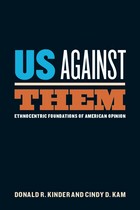 Us Against Them: Ethnocentric Foundations of American Opinion
Donald R. Kinder and Cindy D. Kam
University of Chicago Press, 2009 Ethnocentrism—our tendency to partition the human world into in-groups and out-groups—pervades societies around the world. Surprisingly, though, few scholars have explored its role in political life. Donald Kinder and Cindy Kam fill this gap with Us Against Them, their definitive explanation of how ethnocentrism shapes American public opinion. Arguing that humans are broadly predisposed to ethnocentrism, Kinder and Kam explore its impact on our attitudes toward an array of issues, including the war on terror, humanitarian assistance, immigration, the sanctity of marriage, and the reform of social programs. The authors ground their study in previous theories from a wide range of disciplines, establishing a new framework for understanding what ethnocentrism is and how it becomes politically consequential. They also marshal a vast trove of survey evidence to identify the conditions under which ethnocentrism shapes public opinion. While ethnocentrism is widespread in the United States, the authors demonstrate that its political relevance depends on circumstance. Exploring the implications of these findings for political knowledge, cosmopolitanism, and societies outside the United States, Kinder and Kam add a new dimension to our understanding of how democracy functions.
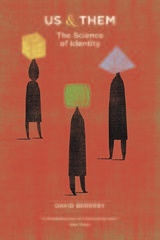 Us and Them: The Science of Identity
David Berreby
University of Chicago Press, 2008 Democrat and Republican. Meat Eaters and Vegetarians. Black and White. As human beings we sort ourselves into groups. And once we identify ourselves as a member of a particular group—say, Red Sox fans—we tend to feel more comfortable with others of our own kind, rather than, say, Yankees fans. Yet we all belong to multiple groups at the same time—one might be a woman, a mother, an American, a violinist. How do we decide which identities matter and why they matter so much? And what makes us willing to die for, or to kill for, a religion, a nation, or a race?
In this award-winning book, David Berreby describes how twenty-first-century science is addressing these age-old questions. Ably linking neuroscience, social psychology, anthropology, and other fields, Us and Them investigates humanity’s “tribal mind” and how this alters our thoughts, affects our health, and is manipulated for good and ill. From the medical effects of stress to the rhetoric of politics, our perceptions of group identity affect every part of our lives. Science, Berreby argues, shows how this part of human nature is both unexpectedly important and surprisingly misunderstood.
Humans need our tribal sense—it tells us who we are, how we should behave, and links us to others as well as the past and future. Some condemn this instinct, while others celebrate it. Berreby offers in Us and Them a third alternative: how we can accept and understand our inescapable tribal mind.
“[A] brave book. . . . Berreby’s quest is to understand what he sees as a fundamental human urge to classify and identify with ‘human kinds.’”—Henry Gee, Scientific American
The U.S. Army in Asia, 2030–2040
Terrence K. Kelly
RAND Corporation, 2014 Looking to the 2030–2040 time frame, U.S. policy and military strategy will need to strike a balance among maintaining a cooperative relationship with China, deterring Chinese aggression in regional disputes, and preparing for the possibility that China could become more assertive. The U.S. Army will have an important role to play in preparing for these developments and for protecting and furthering U.S. interests in the region.
The U.S. Army in Southeast Asia: Near-Term and Long-Term Roles
Peter Chalk
RAND Corporation, 2014 This RAND report examines the U.S. Army role in Southeast Asia. Under current benign conditions, efforts should focus on supporting defense reform, addressing transnational threats, and balancing China. If the outlook deteriorates, the United States should increase security cooperation, conclude new regional basing agreements, expand disaster assistance, and create policies to encourage risk-averse Chinese behavior.
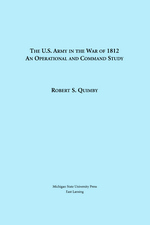 The U.S. Army in the War of 1812
Robert Quimby
Michigan State University Press, 1997 This two-volume work by historian Robert Quimby presents a comprehensive and detailed analysis of military strategy, operations, and management during one of America’s most neglected and least understood military campaigns, the War of 1812. With causes that can be traced to the epic contest against Napoleon in Europe beginning in 1803, the war itself was the first conducted by the young Constitutional government of the United States. Quimby demonstrates that failed American initiatives at the beginning of hostilities shattered the unrealistic optimism of the war’s staunchest advocates; and while initial failures were followed by military success in 1813, whatever advantage might have been gained was soon lost to incompetent leadership. Major exceptions occurred in the Old Northwest, and in what was then the Southwest, where U.S. forces finally broke the strength of the long-successful Indian-British alliance.
In retrospect, what occurred during the War of 1812 demonstrated the necessity for gaining citizen support before committing the nation to armed conflict; it also provided a series of object lessons on how not to conduct a military campaign. Finally Quimby argues that, notwithstanding several victories at war’s end, including the fabled Battle of New Orleans, American perceptions that the United States "won" the war are erroneous; at best the struggle ended in a draw. The United States Army in the War of 1812 is an up-to-date and long overdue reassessment of military actions conducted during a pivotal conflict in American history, one that shaped U.S. military doctrine for a half century.
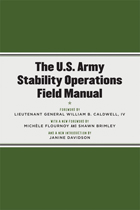 The U.S. Army Stability Operations Field Manual: U.S. Army Field Manual No. 3-07
The United States Army
University of Michigan Press, 2009 Field Manual 3-07, Stability Operations, represents a milestone in Army doctrine. With a focus on transforming conflict, managing violence when it does occur and maintaining stable peace, The U.S. Army Stability Operations Field Manual (otherwise known as FM 3-07) signals a stark departure from traditional military doctrine. The Army officially acknowledges the complex continuum from conflict to peace, outlines the military's responsibility to provide stability and security, and recognizes the necessity of collaboration, coordination, and cooperation among military, state, commercial, and non-government organizations in nation-building efforts. The manual reflects a truly unique collaboration between the Army and a wide array of experts from hundreds of groups across the United States Government, the intergovernmental and non-governmental communities, America's allies around the world, and the private sector. All branches of the armed forces, U.S. agencies ranging from the State Department to Homeland Security to Health and Human Services, international agencies from the United Nations to the Red Cross to the World Bank, countries from the United Kingdom to India to South Africa, private think tanks from RAND to the United States Institute of Peace to the Center for New American Security, all took part in the shaping of this document. The U.S. Army Stability Operations FieldManual, marks just the second time in modern history that the U.S. Army has worked with a private publisher to produce a military doctrinal document. Lieutenant General William B. Caldwell, IV is Commander of the Combined Arms Center at Fort Leavenworth, Kansas. Michèle Flournoy, Under Secretary of Defense for Policy Shawn Brimley, Fellow, Center for a New American Security Janine Davidson, Deputy Assistant Secretary of Defense for Plans "It is a roadmap from conflict to peace, a practical guidebook for adaptive, creative leadership at a critical time in our history. It institutionalizes the hard-won lessons of the past while charting a path for tomorrow. This manual postures our military forces for the challenges of an uncertain future, an era of persistent conflict where the unflagging bravery of our Soldiers will continue to carry the banner of freedom, hope, and opportunity to the people of the world."
—From the foreword by Lieutenant General William B. Caldwell, IV, Commander of the Combined Arms Center at Fort Leavenworth, Kansas
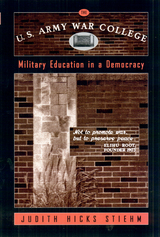 U.S. Army War College: Military Education In A Democracy
Judith Hicks Stiehm
Temple University Press, 2002 We are all familiar with ROTC, West Point, and other institutions that train young men and women to be military officers. But few people know of the U.S. Army War College, where the Army's elite career officers go for advanced training in strategy, national security policy, and military-government policymaking. This book takes readers inside the U.S. Army War College to learn about the faculty, staff, administration, and curriculum.Established in 1901, the school's mission has evolved from teaching the skills of war to training officers to negotiate both the complex world of modern strategy and the civilian bureaucracy in Washington. More like a professional graduate program than an academic graduate school, much of the education takes the form of exercises and simulations.Judith Stiehm, who holds the U.S. Army Distinguished Civilian Service Medal, allows readers to judge whether the U.S. Army War College successfully prepares its students for their many roles. She is skeptical that instructors can fulfill this difficult task in an era where civilians expect our military to be invincible, to win without casualties, and to serve as peacekeepers.The Military answers to the people of the United States and it is our responsibility to know how it operates at all levels. This book is a good place to start.
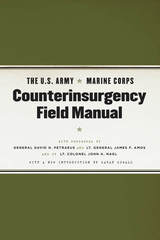 The U.S. Army/Marine Corps Counterinsurgency Field Manual
The United States Army and Marine Corps
University of Chicago Press, 2007 The handbook the US military created to fight counterinsurgencies in the twenty-first century.
When the U.S. military invaded Iraq, it lacked a common understanding of the problems inherent in counterinsurgency campaigns. It had neither studied them, nor developed doctrine and tactics to deal with them. It is fair to say that in 2003, most Army officers knew more about the U.S. Civil War than they did about counterinsurgency.
The U.S. Army / Marine Corps Counterinsurgency Field Manual was written to fill that void. The result of unprecedented collaboration among top U.S. military experts, scholars, and practitioners in the field, the manual espouses an approach to combat that emphasizes constant adaptation and learning, the importance of decentralized decision-making, the need to understand local politics and customs, and the key role of intelligence in winning the support of the population. The manual also emphasizes the paradoxical and often counterintuitive nature of counterinsurgency operations: sometimes the more you protect your forces, the less secure you are; sometimes the more force you use, the less effective it is; sometimes doing nothing is the best reaction.
An new introduction by Sarah Sewall, director of the Carr Center for Human Rights Policy at Harvard’s Kennedy School of Government, places the manual in critical and historical perspective, explaining the significance and potential impact of this revolutionary challenge to conventional U.S. military doctrine.
An attempt by our military to redefine itself in the aftermath of 9/11 and the new world of international terrorism, The U.S. Army / Marine Corps Counterinsurgency Field Manual will play a vital role in American military campaigns for years to come.
The University of Chicago Press will donate a portion of the proceeds from this book to the Fisher House Foundation, a private-public partnership that supports the families of America’s injured servicemen. To learn more about the Fisher House Foundation, visit www.fisherhouse.org.
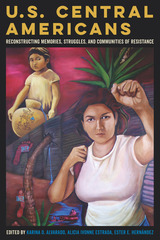 U.S. Central Americans: Reconstructing Memories, Struggles, and Communities of Resistance
Edited by Karina O. Alvarado, Alicia Ivonne Estrada, and Ester E. Hernández
University of Arizona Press, 2017 In summer 2014, a surge of unaccompanied child migrants from Central America to the United States gained mainstream visibility—yet migration from Central America has been happening for decades. U.S. Central Americans explores the shared yet distinctive experiences, histories, and cultures of 1.5-and second-generation Central Americans in the United States. While much has been written about U.S. and Central American military, economic, and political relations, this is the first book to articulate the rich and dynamic cultures, stories, and historical memories of Central American communities in the United States. Contributors to this anthology—often writing from their own experiences as members of this community—articulate U.S. Central Americans’ unique identities as they also explore the contradictions found within this multivocal group. Working from within Guatemalan, Salvadoran, and Maya communities, contributors to this critical study engage histories and transnational memories of Central Americans in public and intimate spaces through ethnographic, in-depth, semistructured, qualitative interviews, as well as literary and cultural analysis. The volume’s generational, spatial, urban, indigenous, women’s, migrant, and public and cultural memory foci contribute to the development of U.S. Central American thought, theory, and methods. Woven throughout the analysis, migrants’ own oral histories offer witness to the struggles of displacement, travel, navigation, and settlement of new terrain. This timely work addresses demographic changes both at universities and in cities throughout the United States. U.S. Central Americans draws connections to fields of study such as history, political science, anthropology, ethnic studies, sociology, cultural studies, and literature, as well as diaspora and border studies. The volume is also accessible in size, scope, and language to educators and community and service workers wanting to know about their U.S. Central American families, neighbors, friends, students, employees, and clients. Contributors: Leisy Abrego
Karina O. Alvarado
Maritza E. Cárdenas
Alicia Ivonne Estrada
Ester E. Hernández
Floridalma Boj Lopez
Steven Osuna
Yajaira Padilla
Ana Patricia Rodríguez
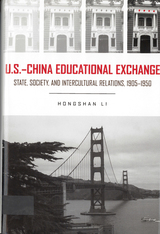 U.S.- China Educational Exchange: State, Society, and Intercultural Relations, 1905-1950
Li, Hongshan
Rutgers University Press, 2007 U.S.-China relations became increasingly important and complex in the twentieth century. While economic, political, and military interactions all grew over time, the most dramatic expansion took place in educational exchange, turning it into the strongest tie between the two nations. By the end of the 1940s, tens of thousands of Chinese and American students and scholars had crisscrossed the Pacific, leaving indelible marks on both societies. Although all exchange programs were terminated during the cold war, the two nations reemerged as top partners within a decade after the reestablishment of diplomatic relations. Approaching U.S.-China relations from a unique and usually overlooked perspective, Hongshan Li reveals that both the drastic expansion and complete termination of educational ties between the two nations in the first half of the twentieth century were largely the results of direct and deep intervention from the American and Chinese governments. Benefiting from government support and collaboration, educational exchange succeeded in diffusing knowledge and improving mutual understanding between the two peoples across the divide of civilizations. However, the visible hand of government also proved to be most destructive to the development of healthy intercultural relations when educational interactions were treated merely as an instrument for crisis management.
The U.S. Constitution: A Reader
Hillsdale College Politics Faculty
American Philanthropic, 2011
Featuring 113 primary source documents, The U.S. Constitution: A Reader was developed for teaching the core course on the U.S. Constitution at Hillsdale College. Divided into eleven sections with introductions by members of Hillsdale's Politics Department faculty, readings cover the principles of the American founding; the framing and structure of the Constitution; the secession crisis and the Civil War; the Progressive rejection of the Constitution; and the building of the administrative state based on Progressive principles.
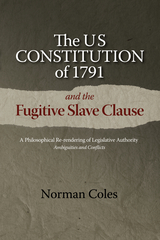 The US Constitution of 1791 and the Fugitive Slave Clause: A Philosophical Re-rendering of Legislative Authority
Norman Coles
Sussex Academic Press, 2022 Norman Coles presents arguments which show that the Fugitive Slave Clause has at least two (and possibly three) meanings. Stewart's arguments are about Constitutional principles, not the practical consequences of believing the Clause was law. Stewart's reasoning is penetrating; arguments relating to ambiguity and legal jargon are superseded by the logical consequence of the fact that if the Clause is about fugitive slaves, its legality rests on false assumptions. Herein lay the potential to avoid a historical tragedy. In the course of time legal and political champions, in conjunction with a growing number of US States, favoured laws which barred slave-hunting, but in the interim legal inadequacy resulted in the unnecessary continuation of slave-holding. This publication is a fundamental reconsideration of the intertwining of American History and American Constitutional Law.
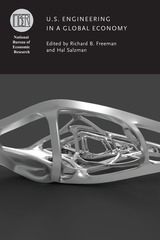 U.S. Engineering in a Global Economy
Edited by Richard B. Freeman and Hal Salzman
University of Chicago Press, 2018 Since the late 1950s, the engineering job market in the United States has been fraught with fears of a shortage of engineering skill and talent. U.S. Engineering in a Global Economy brings clarity to issues of supply and demand in this important market. Following a general overview of engineering-labor market trends, the volume examines the educational pathways of undergraduate engineers and their entry into the labor market, the impact of engineers working in firms on productivity and innovation, and different dimensions of the changing engineering labor market, from licensing to changes in demand and guest worker programs.
The volume provides insights on engineering education, practice, and careers that can inform educational institutions, funding agencies, and policy makers about the challenges facing the United States in developing its engineering workforce in the global economy.
 US Expansionism: The Imperialist Urge in the 1890s
David Healy
University of Wisconsin Press, 1976 Americans, in viewing the globe in 1897, saw a world of empires that were dynamic and fast-growing. Western powers such as Germany, France, and particularly Great Britain were making colonial imperialism fashionable, and the United States, eager to flex its muscles as an emerging world power, was swept along with the European tide. One year later, the United States had truly established itself as a contender in the global game, victorious in a war with Spain and committed to imperialism.
In US Expansionism, David Healy examines this brief but important chapter in American history. Analyzing the various intellectual, cultural, and economic forces that engendered and shaped America’s imperialist drive, Healy also illustrates the key personalities involved, including the soon-to-be president, Theodore Roosevelt. A final section of the book examines the anti-imperialist opposition inspired by the new policy, and the ensuing debates about the proper role of American power.
The U.S. Experiment in Social Medicine: The Community Health Center Program, 1965–1986
Alice Sardell
University of Pittsburgh Press, 1989 This book represents the first political history of the federal government's only experiment in social medicine. Alice Sardell examines the Neighborhood, or Community Health Center Program (NHC/CHC) from its origins in 1965 as part of Lyndon Johnson's War on Poverty campaign up until 1986. The program embodied concepts of social medicine, community development, and consumer involvement in health policy decision-making. Sardell views the NHC experiment in the context of a series of political struggles, beginning in the 1890s, over the boundaries of public and private medicine, and demonstrates that these health centers so challenged mainstream medicine that they could only be funded as a program limited to the poor.
US Foreign Policy After The Cold War
Randall B. Ripley
University of Pittsburgh Press, 1997
The cold war came to a grinding halt during the astounding developments of 1989-1991. The Berlin Wall fell, Eastern European countries freed themselves from Soviet domination, and the Soviet Union itself disintegrated after witnessing a failed coup presumably aimed at restoring a communist dictatorship. Suddenly the “evil empire” was no more, and U.S. foreign policy was forever changed. This volume explores the revisions to a variety of bureaucratic institutions and policy areas in the wake of these political upheavals.
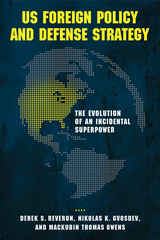 US Foreign Policy and Defense Strategy: The Evolution of an Incidental Superpower
Derek S. Reveron, Nikolas K. Gvosdev, and Mackubin Thomas Owens
Georgetown University Press, 2015 Safe from the battlefields of Europe and Asia, the United States led the post–World War II global economic recovery through international assistance and foreign direct investment. With an ardent decolonization agenda and a postwar legitimacy, the United States attempted to construct a world characterized by cooperation. When American optimism clashed with Soviet expansionism, the United States started on a path to global hegemony. In US Foreign Policy and Defense Strategy, the authors analyze the strategic underpinnings of hegemony, assess the national security establishment that sustains dominance, consider the impact on civil-military relations, and explore the intertwining relationships between foreign policy, defense strategy, and commercial activities. Eschewing conventional analyses, the volume not only identifies drivers and continuities in foreign policy, but it also examines how the legacy of the last sixty-five years will influence future national security policy that will be characterized by US leadership in an increasingly competitive world. From civil-military relations to finance, and from competing visions of how America should make war to its philosophy of securing peace through reconstruction and reconciliation, US Foreign Policy and Defense Strategy offers unique insights into the links between military and commercial power as it charts the rise of a historical rarity: the incidental superpower. This accessibly written book is suitable for students and general readers as well as scholars.
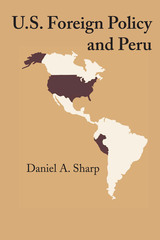 U.S. Foreign Policy and Peru
By Daniel A. Sharp
University of Texas Press, 1972 This book presents the first authoritative and comprehensive account of the development of the Peruvian revolution of 1968. The study resulted from a team experiment in applied political science, economics, and sociology that maintained effective communications between Peru and the United States at many levels during the difficult years following the revolution. Each chapter is the result of continuous interaction between a leading authority and the major sectors of both societies. History is here presented in its diplomatic, social, economic, and cultural context. The Peruvian and U.S. governments helped to define the subjects of greatest interest to their respective countries, and a systematic effort was made to find the leading authorities on each issue. Since one purpose of this volume is to affect policy by identifying new alternative policies, the papers included here were prepared specifically to be of value to policy makers. This book was produced by a citizens’ constituency on U.S. foreign policy under the auspices of the Adlai Stevenson Institute of International Affairs, the Chicago Council on Foreign Relations, and the Johnson Foundation.
 U.S. Foreign Policy in the Middle East: The Role of Lobbies and Special Interest Groups
Janice J. Terry
Pluto Press, 2005 Millions of dollars are spent every year by companies and special interest groups attempting to influence government policy. They work behind the scenes, lobbying politicians to represent their interests. From tobacco companies, to energy companies, from anti-abortion campaigners to civil rights campaigners, the list is vast. And nowhere is their influence more keenly felt than on the issue of the Middle East.
Israel is America's key ally in the Middle East, and helps maintain U.S. dominance in the region. This book shows how pro-Israeli lobbyists and domestic interest groups have been hugely successful in creating government and financial support for Israel. By contrast, Arab-American groups and Arab governments have had less success putting forward their agencies.
Janice J. Terry shows how special interest groups work, and why certain lobbying techniques are more effective than others. She sets this within the wider cultural context, showing how the U.S. media -- and the general public -- view the Middle East.
To explain how lobbies work, Terry draws on case studies including the Sinai accords and Camp David under Presidents Ford and Carter, the Conflict between Green and Turkish lobbies over Cyprus, and the major campaign against the Arab boycott.
Making use of primary sources, and unpublished material from various presidential libraries, this is a fascinating exposé of the role that lobby groups really play in determining U.S. foreign policy in the Middle East. It will be of interest to students of American politics and Middle East studies.
U.S. International Economic Strategy in a Turbulent World: Strategic Rethink
Howard J. Shatz
RAND Corporation, 2016 This report presents strategic choices America faces regarding the international economy over the term of the next U.S. administration, focusing on policy choices in the areas of maintaining and improving the rules-based international economic system; working with China and better integrating it into the existing system; supporting economic growth of allies and partners; and using sanctions to change unwanted behavior and counter adversaries.
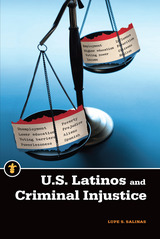 U.S. Latinos and Criminal Injustice
Lupe S. Salinas
Michigan State University Press, 2015 Latinos in the United States encompass a broad range of racial, socioeconomic, and sociopolitical identities. Originating from the Caribbean, Spain, Central and South America, and Mexico, they have unique justice concerns. The ethnic group includes U.S. citizens, authorized resident aliens, and undocumented aliens, a group that has been a constant partner in the Latino legal landscape for over a century. This book addresses the development and rapid growth of the Latino population in the United States and how race-based discrimination, hate crimes, and other prejudicial attitudes, some of which have been codified via public policy, have grown in response. Salinas explores the degrading practice of racial profiling, an approach used by both federal and state law enforcement agents; the abuse in immigration enforcement; and the use of deadly force against immigrants. The author also discusses the barriers Latinos encounter as they wend their way through the court system. While all minorities face the barrier of racially based jury strikes, bilingual Latinos deal with additional concerns, since limited-English-proficient defendants depend on interpreters to understand the trial process. As a nation rich in ethnic and racial backgrounds, the United States, Salinas argues, should better strive to serve its principles of justice.
The U.S. National Income and Product Accounts: Selected Topics
Murray F. Foss
University of Chicago Press, 1983 The main topics treated in this conference volume are problems of deflation and quality change, the adequacy of the data used to construct the U.S. national accounts, and the broad theoretical evolution of the U.S. national income and product accounts. As these topics suggest, this volume represents a new stage in the study of national income and product accounts in that emphasis is placed on the information content of the system rather than on the structure of the accounts. This new emphasis is highlighted by the inclusion of a discussion among prominent users of the national accounts—Lawrence Klein, Otto Eckstein, Alan Greenspan, and Arthur Okun—that indicates the difficulties that confront those who utilize this information.
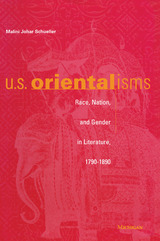 U.S. Orientalisms: Race, Nation, and Gender in Literature, 1790-1890
Malini Johar Schueller
University of Michigan Press, 2001 U.S. Orientalisms is the first extensive and politicized study of nineteenth century American discourses that helped build an idea of nationhood with control over three "Orients": the "Barbary" Orient; the Orient of Egypt; and the Orient of India. Malini Johar Schueller persuasively argues that current notions about the East can be better understood as latter-day manifestations of the earlier U.S. visions of the Orient refracted variously through millennial fervor, racial-cultural difference, and ideas of Westerly empire.
This book begins with an examination of the literature of the "Barbary" Orient generated by the U.S. Algerian conflict in the late eighteenth century in the works of such writers as Royall Tyler, Susanna Rowson, and Washington Irving. It then moves on to the Near East Orientalist literature of the nineteenth century in light of Egyptology, theories of race, and the growth of missionary fervor in writers such as John DeForest, Maria Susanna Cummins, Herman Melville, Edgar Allan Poe, and Harriet Prescott Spofford. Finally, Schueller considers the Indic Orientalism of the period in the context of Indology, British colonialism, and the push for Asian trade in the United States, focusing particularly on Emerson and Whitman. U.S. Orientalisms demonstrates how these writers strove to create an Orientalism premised on the idea of civilization and empire moving West, from Asia, through Europe, and culminating in the New World.
Schueller draws on the work of Michel Foucault, Edward Said, Homi Bhabha, Rey Chow, and Judith Butler and compellingly demonstrates how a raced, compensatory "Orientalist" discourse of empire was both contested and evoked in the literary works of a wide variety of writers. The book will be of interest to readers in American history, postcolonial studies, gender studies, and literary theory.
Malini Johar Schueller is Associate Professor, Department of English, University of Florida. She is the author of The Politics of Voice: Liberalism and Social Criticism from Franklin to Kingston.
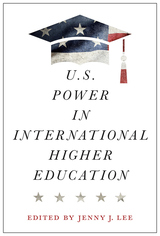 U.S. Power in International Higher Education
Jenny J. Lee
Rutgers University Press, 2021 2021 ASHE/CIHE Award for Significant Research on International Higher Education
U.S. Power in International Higher Education explores how internationalization in higher education is not just an educational endeavor, but also a geopolitical one. By centering and making explicit the role of power, the book demonstrates the United States’s advantage in international education as well as the changing geopolitical realities that will shape the field in the future. The chapter authors are leading critical scholars of international higher education, with diverse scholarly ties and professional experiences within the country and abroad. Taken together, the chapters provide broad trends as well as in-depth accounts about how power is evident across a range of key international activities. This book is intended for higher education scholars and practitioners with the aim of raising greater awareness on the unequal power dynamics in internationalization activities and for the purposes of promoting more just practices in higher education globally.
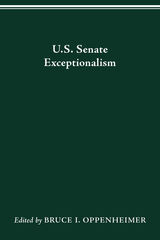 U.S. SENATE EXCEPTIONALISM
Edited by Bruce I. Oppenheimer
Ohio State University Press, 2002 This collection includes the most recent scholarship on the U.S. Senate. Whereas most books simply assume that research about the House of Representatives holds equally well when applied to the Senate, this volume takes as its point of departure research about the Senate itself. This gives the reader a clear understanding of the particular nature of the institution and opens the door for further, refining research. Drawing on diverse methodologies, this book’s synthesizing work will be essential reading for all scholars of U.S. politics. The chapters are written by leading congressional scholars and cover topics including representation, elections, committees, party leadership, policy influence, and constitutional powers. Contributors: - Alan I. Abramowitz
- John R. Alford
- David T. Canon
- Joseph Cooper
- Lawrence C. Dodd
- Robert S. Erikson
- C. Lawrence Evans
- Richard Fenno Jr.
- Gerald Gamm
- John R. Hibbing
- Kim Fridkin Kahn
- Patrick J. Kenney
- Frances D. Lee
- Burdett Loomis
- Bruce I. Oppenheimer
- David W. Rohde
- Elizabeth Rybicki
- Wendy J. Schiller
- Patrick J. Sellers
- Barbara Sinclair
- Steven Smith
- Charles Stewart III
U.S. Special Operations Forces in the Philippines, 2001–2014
Linda Robinson
RAND Corporation, 2016 This report examines the 14-year experience of U.S. special operations forces in the Philippines from 2001 through 2014 and the activities and effects of special operations capabilities employed to address terrorist threats in Operation Enduring Freedom—Philippines through training and equipping Philippine security forces, providing operational advice and assistance, and conducting civil–military and information operations.
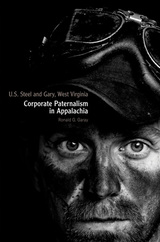 U.S. Steel and Gary, West Virginia: Corporate Paternalism in Appalachia
Ronald G. Garay
University of Tennessee Press, 2011
“This book is well written and meticulously documented; it will add significantly to the available literature on West Virginia’s industrial and community history. It should find a receptive audience among college and post- graduate scholars of industrial and labor history, West Virginia history, and Appalachian studies.”
—John Lilly, editor, Goldenseal
The company owned the houses. It owned the stores. It provided medical and governmental
services. It provided practically all the jobs. Gary, West Virginia, a coal mining town in the southern part of the state, was a creation of U.S. Steel. And while the workers were not formally bound to the company, their fortunes—like that of their community—were inextricably tied to the success of U.S. Steel.
Gary developed in the early twentieth century as U.S. Steel sought a new supply of raw material for its industrial operations. The rich Pocahontas coal field in remote southern West Virginia provided the carbon-rich, low-sulfur coal the company required. To house the thousands of workers it would import to mine that coal bed, U.S. Steel carved a town out of the mountain wilderness. The company was the sole reason for its existence.
In this fascinating book, Ronald Garay tells the story of how industry-altering decisions made by U.S. Steel executives reverberated in the hollows of Appalachia. From the area’s industrial revolution in the early twentieth century to the peak of steel-making activity in the 1940s to the industry’s decline in the 1970s, U.S. Steel and Gary, West Virginia offers an illuminating example of how coal and steel paternalism shaped the eastern mountain region and the limited ways communities and their economies evolve. In telling the story of Gary, this volume freshly illuminates the stories of other mining towns throughout Appalachia.
At once a work of passionate journalism and a cogent analysis of economic development in Appalachia, this work is a significant contribution to the scholarship on U.S. business history, labor history, and Appalachian studies.
Ronald Garay, a professor emeritus of mass communication at Louisiana State University,
is the author of Gordon McLendon: The Maverick of Radio and The Manship School: A History of Journalism Education at LSU.
 The U.S. Supreme Court and the Electoral Process: Second Edition
David K. Ryden, Editor
Georgetown University Press, 2002 The U.S. Supreme Court—at least until Bush v. Gore—had seemed to float along in an apolitical haze in the mind of the electorate. It was the executive branch and the legislative branch that mucked about in politics getting dirty, the judicial branch kept its robes—and nose—clean. The U.S. Supreme Court and the Electoral Process makes it abundantly clear however that before, during, and after the judicial decision that made George W. Bush the President of the United States, everything was, is, and will likely be, politics-including the decisions handed down by the highest court in the land. This revised and updated edition takes into account not only the recent famous (or infamous, depending on the reader's point of view) judicial decision on the Presidency, but a myriad of others as well in which the U.S. Supreme Court has considered the constitutionality of a wide range of issues involving voting and elections, representation, and political participation. Practitioners and academics in both law and political science examine a number of court actions that directly affect how we choose those who govern us, and how those decisions have affected our electoral politics, constitutional doctrine, and the fundamental concepts of democracy, including: racial redistricting, term limits, political patronage, campaign finance regulations, third-party ballot access, and state ballot initiatives limiting civil liberties. Of the first edition, CHOICE said, The U.S. Supreme Court and the Electoral Process "plumbs the Supreme Court's constitutive apolitical role as 'primary shaper of the electoral system' and reveals the pervasive involvement of the Court in the political process."
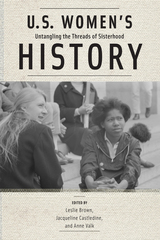 U.S. Women's History: Untangling the Threads of Sisterhood
Brown, Leslie
Rutgers University Press, 2017 In the 1970s, feminist slogans proclaimed “Sisterhood is powerful,” and women’s historians searched through the historical archives to recover stories of solidarity and sisterhood. However, as feminist scholars have started taking a more intersectional approach—acknowledging that no woman is simply defined by her gender and that affiliations like race, class, and sexual identity are often equally powerful—women’s historians have begun to offer more varied and nuanced narratives. The ten original essays in U.S. Women's History represent a cross-section of current research in the field. Including work from both emerging and established scholars, this collection employs innovative approaches to study both the causes that have united American women and the conflicts that have divided them. Some essays uncover little-known aspects of women’s history, while others offer a fresh take on familiar events and figures, from Rosa Parks to Take Back the Night marches. Spanning the antebellum era to the present day, these essays vividly convey the long histories and ongoing relevance of topics ranging from women’s immigration to incarceration, from acts of cross-dressing to the activism of feminist mothers. This volume thus not only untangles the threads of the sisterhood mythos, it weaves them into a multi-textured and multi-hued tapestry that reflects the breadth and diversity of U.S. women’s history.
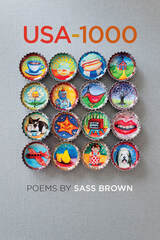 USA-1000
Sass Brown
Southern Illinois University Press, 2016 Sass Brown’s darkly funny debut collection of poems explores both the isolation and the absurdity of twenty-something apartment living. The world Brown creates in USA-1000 overflows with infomercials, classic Hollywood films, billboard messages, strip clubs, and fortune-tellers, illuminating our complex relationship with consumerism. In the absence of personal intimacy, everyday objects take on unexpected importance: the clothing of a would-be couple mingles in a washing machine; a father watches pornography in a hotel room with his wife and daughter; a woman searches a shopping mall to put on hold items she’ll never buy; a broken hair dryer prompts a complaint letter to the Better Business Bureau. Brown’s dazzling poems probe the disappointment of domestic reality in the face of America’s glossy facade, abundance and emptiness hand in hand. Ultimately, the book finds beauty in the deliciously artificial and resurrects “the missing world” with words and memory.
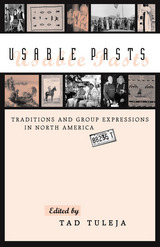 Usable Pasts: Traditions and Group Expressions in North America
Tad Tuleja
Utah State University Press, 1997 In Usable Pasts, fourteen authors examine the manipulation of traditional expressions among a variety of groups from the United States and Canada: the development of a pictorial style by Navajo weavers in response to traders, Mexican American responses to the appropriation of traditional foods by Anglos, the expressive forms of communication that engender and sustain a sense of community in an African American women's social club and among elderly Yiddish folksingers in Miami Beach, the incorporation of mass media images into the "C&Ts" (customs and traditions) of a Boy Scout troop, the changing meaning of their defining Exodus-like migration to Mormons, Newfoundlanders' appropriation through the rum-drinking ritual called the Schreech-In of outsiders' stereotypes, outsiders' imposition of the once-despised lobster as the emblem of Maine, the contest over Texas's heroic Alamo legend and its departures from historical fact, and how yellow ribbons were transformed from an image in a pop song to a national symbol of "resolve."
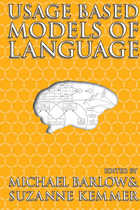 Usage Based Models of Language
Edited by Michael Barlow and Suzanne Kemmer
CSLI, 2000 How do humans learn how to speak and understand language? For years, linguists have developed numerous models in attempts to explain humans' ability to communicate through language. Historically, these approaches were rooted and restricted in rule-based linguistic representations. Only recently has the field of linguistics been willing to forego formal representations and models to accommodate the usage-based perspective of studying language.
Deviating from traditional methods, the contributions presented in this volume are among the first works to approach linguistic theory by developing and utilizing usage-based models. The contributing authors were among the principal leaders in their fields to leave behind rule-based linguistic representations in favor of constraint-based systems whose structural properties actually emerge from usage. The volume begins with an introductory chapter that defines contributors' interpretations of usage-based models and theories of language. The reason for the shift from formal linguistic theories to the gradual acceptance of usage-based models is also examined. Using methods such as Cognitive Grammar, the Lexical Network Model, Competition Model, Relational Network Theory, and Accessibility Theory, the selected works demonstrate how usage-based models evince far greater cognitive and neurological plausibility than algorithmic, generative models.
Usage of Idem, Ipse and Words of Related Meaning
Clarence L. Meader
University of Michigan Press, 1910 This book presents a detailed analysis of two Latin pronouns, idem and ipse. Consideration is given to synonymously and etymologically related words in Latin and other Indo-European languages.
 The Usage-based Study of Language Learning and Multilingualism
Lourdes Ortega, Andrea E. Tyler, Hae In Park, and Mariko Uno, Editors
Georgetown University Press When humans learn languages, are they also learning how to create shared meaning? In The Usage-based Study of Language Learning and Multilingualism, a cadre of international experts say yes and offer cutting-edge research in usage-based linguistics to explore how language acquisition, in particular multilingual language acquisition, works. Each chapter presents an original study that supports the view that language learning is initiated through local and meaningful communication with others. Over an accumulated history of such usage, people gradually create more abstract, interactive schematic representations, or a mental grammar. This process of acquiring language is the same for infants and adults and across varied contexts, such as the family, the classroom, the laboratory, a hospital, or a public encounter. Employing diverse methodologies to study this process, the contributors here work with target languages, including Cantonese, English, French, French Sign Language, German, Hebrew, Malay, Mandarin, Spanish, and Swedish, and offer a much-needed exploration of this growing area of linguistic research.
The U.S.-China Military Scorecard: Forces, Geography, and the Evolving Balance of Power, 1996–2017
Eric Heginbotham
RAND Corporation, 2015 A RAND study analyzed Chinese and U.S. military capabilities in two scenarios (Taiwan and the Spratly Islands) from 1996 to 2017, finding that trends in most, but not all, areas run strongly against the United States. While U.S. aggregate power remains greater than China’s, distance and geography affect outcomes. China is capable of challenging U.S. military dominance on its immediate periphery—and its reach is likely to grow in the years ahead.
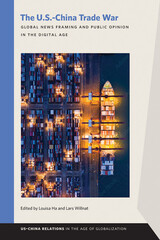 The U.S.–China Trade War: Global News Framing and Public Opinion in the Digital Age
Louisa Ha
Michigan State University Press, 2022 Drawing on data from three national surveys, three content analyses, computational topic modeling, and rhetorical analysis, The U.S.–China Trade War sheds light on the twenty-first century’s most high-profile contest over global trade to date. Through diverse empirical studies, the contributors examine the effects of news framing and agenda-setting during the trade war in the Chinese and U.S. news media. Looking at the coverage of Chinese investment in the United States, the use of peace and war journalism frames, and the way media have portrayed the trade war to domestic audiences, the studies explore how media coverage of the trade war has affected public opinion in both countries, as well as how social media has interacted with traditional media in creating news. The authors also analyze the roles of traditional news media and social media in international relations and offer insights into the interactions between professional journalism and user-generated content—interactions that increasingly affect the creation and impact of global news. At a time when social media are being blamed for spreading misinformation and rumors, this book illustrates how professional and user-generated media can reduce international conflicts, foster mutual understanding, and transcend nationalism and ethnocentrism.
Use and Appreciation of Mycenaean Pottery: In the Levant, Cyprus and Italy (ca. 1600-1200 BC)
Gert Jan vana Wijngaarden
Amsterdam University Press, 2003 Pottery made in the Aegean during the Late Bronze Age has been found in many parts of the Mediterranean—Mycenaean dinner and storage vessels, for example, have been discovered at some four hundred sites outside Greece. These artifacts provide one of the main sources of information on Mycenaean trade and interregional contact, but the role of pottery in international exchange during this period is still not properly understood. Gert Jan van Wijngaarden brings us closer with this study, which investigates patterns of consumption for the three biggest importers of Mycenaean pottery: the Levant, Cyprus, and Italy.
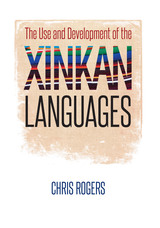 The Use and Development of the Xinkan Languages
By Chris Rogers
University of Texas Press, 2016 Once spoken only in Santa Rosa Department, Guatemala, the Xinkan language family is unique within Mesoamerica, comprising four closely related languages that are unrelated to any of the other language groups used within the region. Descriptions of Xinkan date to 1770 but are typically only sketches or partial word lists. Not even the community of indigenous people who identify as Xinka today—the last speakers—have had access to a reliable descriptive source on their ancestral tongue. Preserving this endangered communication system in accurate, thorough detail, The Use and Development of the Xinkan Languages presents a historical framework, internal classifications, and both synchronic and diachronic descriptions, incorporating all elements of grammar based on extensive unpublished data collected in the 1970s by Lyle Campbell and Terrence Kaufman. This valuable contribution is enhanced by author Chris Rogers’s emphasis on contextualizing the findings. Introducing the languages, Rogers presents important information regarding the social and cultural milieu of the speakers. He also traces a phonological reconstruction of Proto-Xinkan and reconstructs historical morphology and syntax. These revelations are of particular interest because the development of Xinka and the many aspects of Xinka morphosyntax have not been well understood. A sample text, “Na Mulha Uy,” is included as well. Solving numerous complex, centuries-old linguistic puzzles, The Use and Development of the Xinkan Languages unlocks new potential for the rediscovery of a rich cultural history. This book is a part of the Recovering Languages and Literacies of the Americas publication initiative, funded by a grant from the Andrew W. Mellon Foundation.
 The Use of Books and Libraries
Harold Russell
University of Minnesota Press, 1933
The Use of Books and Libraries was first published in 1933. Minnesota Archive Editions uses digital technology to make long-unavailable books once again accessible, and are published unaltered from the original University of Minnesota Press editions.This is the tenth edition, revised, of the books of the same title by Harold G. Russell, Blanche E Moen, and Raymond H. Shove. A guide to reference books, it is intended primarily for use in courses in library instruction for college undergraduates. The material in this edition has been reorganized for more convenient use, following in general the arrangement in general of Constance Winchell’s Guide to Reference Books, the major reference guide in English. This new edition lists as main entries some 440 reference books and other bibliographical aids, as compared with about 315 such entries in the previous edition. Additional titles mentioned in annotations have been increased from 75 to 165.
The Use of Confessionary Evidence under the Counter-Terrorism Laws of Sri Lanka: An Interdisciplinary Study
Visakesa Chandrasekaram
Amsterdam University Press, 2017 For more than three decades, the Liberation Tigers of Tamil Eelam (LTTE) fought a gruesome war for independence against the majoritarian Sinhalese government of Sri Lanka. Even as the government fought LTTE on the battlefield, it also pursued a legal war through the enactment of counterterrorism laws that permitted indefinite detention and the use of confessions as sole evidence. This book applies theoretical insights from the work of philosophers such as Carl Schmitt, Giorgio Agamben, and Michel Foucault to the Sri Lankan context to examine the conflicting narratives relating to these laws produced by both sides in the conflict.
The Use of Land and Water Resources in the Past and Present Valley of Oaxaca, Mexico
Anne V. T. Kirkby
University of Michigan Press, 1973 In the first volume of a series on Prehistory and Human Ecology of the Valley of Oaxaca, Anne V. T. Kirkby investigated the agricultural production in the valley. With land-use data gathered at the time of her study (the 1960s), she created population and distribution models to help archaeologists interpret prehistoric settlement patterns in the region.
The Use of Language
Prashant Parikh
CSLI, 2001 Building on the work of J. L. Austin and Paul Grice, The Use of Language develops an original and systematic game-theoretic account of communication, speaker meaning, and addressee interpretation, extending this analysis to conversational implicature and the Gricean maxims, illocutionary force, miscommunication, visual representation and visual implicature, and aspects of discourse.
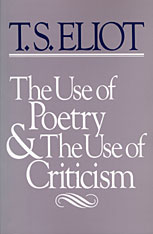 The Use of Poetry and the Use of Criticism: Studies in the Relation of Criticism to Poetry in England
T. S. Eliot
Harvard University Press, 1961 The elder statesman of literary modernism traces the reciprocal relationship between poet and critic.
No individual did more to shape the trajectory of twentieth-century criticism than T. S. Eliot. A self-described “classicist,” his repudiation of the Romantic era’s emphasis on subjectivity and self-expression in favor of a rigorous analytical focus on literary tradition influenced critics for generations to come.
Yet Eliot was not entirely comfortable with his place in the canon. “Tradition and the Individual Talent,” the universally anthologized 1919 essay that laid out his views in their most programmatic form, was, in his own estimation, “the most juvenile” of his critical writings. He believed that the 1932–1933 Norton Lectures collected here, in contrast, reflected his mature thought. In place of the sweeping pronouncements of his earlier work, these lectures offer a shrewd and sensitive account of criticism as a product of history. Beginning with the development of the field in the age of John Dryden, when critics turned poetry into the province of an intellectual aristocracy, Eliot explores how a long line of English poet-critics responded to the unique demands of their time. Johnson, Wordsworth, Coleridge, Shelley, Keats, Arnold, and Richards each mined the past to offer a fresh answer to the question, “what is poetry?” And Eliot brilliantly shows how the poetic strengths—and shortcomings—of each were intimately connected to their critical work.
Trenchant and authoritative, The Use of Poetry and the Use of Criticism reveals that Eliot himself is no exception to this rule. His deep erudition, his existential doubts, and his yearning for order animate these lectures as much as his best poems.
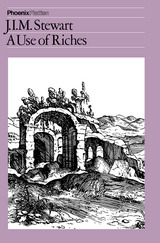 The Use of Riches
J. I. M. Stewart
University of Chicago Press, 1983 Art is very much part of Rupert Craine's life. He is a banker and country squire, but also a connoisseur and collector of art. His beautiful and wealthy wife, Jill, is the widow of John Arnander, an artist of genius killed in Italy in World War II. The Craines live happily on a comfortable country estate with Jill's twelve- and eleven-year-old sons by Arnander and their own two young children. As Jill remarks, an almost Edwardian order reigns in the household. "Of course," she says, "none of it may last."
That afternoon she has received a cable from an old acquaintance, an Italian marchesa. It seems that Arnander fathered an illegitimate son whom the archesa has been looking after. She can no longer do so and wants Jill to come and arrange the boy's future. The Crains hasten to Italy, Rupert going along to the preliminary interview with the marchesa, as he is suspicous that there may not really be an Arnander child, that this is a ruse to extract money.
The truth revealed to him by the marchesa is shattering, and the quintessentially civilized Craines find themselves plunged into an increasingly bizarre drama.
 The Use of Social Science Data in Supreme Court Decisions
Rosemary J. Erickson and Rita J. Simon
University of Illinois Press, 1998 The legal community traditionally has drawn unsystematically and at will on the findings of social science, sometimes with unfortunate results. The authors of this study explore this issue by focusing on the way the United States Supreme Court uses social science data in reaching its decisions. Concentrating on decisions involving abortion, sex discrimination, and sexual harassment, they show that the use of such data has increased over the last twenty years, but that the data's use by the court appears to hinge more on the judges' liberal, conservative, or long-held positions and the types of cases involved than on the objectivity or validity of the data.
By offering insights into how data are used by the Supreme Court, the authors hope to show social scientists how to make their research more suitable for courtroom use and to show the legal community how such data can be used more effectively. The volume includes an overview of the kinds of research used, a list of cases in which such research was used, and a discussion of justices and how they voted on cases in which such data were used from 1972 to 1992.
Use Trouble
Michael Harper
University of Illinois Press, 2008 For decades, Michael S. Harper has written poetry that speaks with many voices. His work teems with poetry configured as awe, poetry as courtship, and poetry as elegy and homage. Infused with tales and riddles, sass and satire and surprise, Harper’s poetry takes the form of psalms, jazz experiments, soft serenades, and radical provocations. In Use Trouble, his first major collection since Songlines in Michaeltree, Harper renews poetry as the art of taking nothing for granted. In three groups--"The Fret Cycle," "Use Trouble," and "I Do Believe in People"--he draws on his seemingly inexhaustible resources to paint, sing, sympathize, and sorrow. Here are his tributes to his father and family, his irrepressible playfulness, and his lifelong romance between poetry and music.
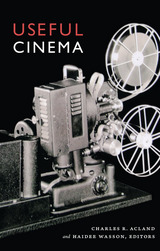 Useful Cinema
Charles R. Acland and Haidee Wasson, eds.
Duke University Press, 2011 By exploring the use of film in mid-twentieth-century institutions, including libraries, museums, classrooms, and professional organizations, the essays in Useful Cinema show how moving images became an ordinary feature of American life. In venues such as factories and community halls, people encountered industrial, educational, training, advertising, and other types of “useful cinema.” Screening these films transformed unlikely spaces, conveyed ideas, and produced subjects in the service of public and private aims. Such functional motion pictures helped to shape common sense about cinema’s place in contemporary life. Whether measured in terms of the number of films shown, the size of audiences, or the economic activity generated, the “non-theatrical sector” was a substantial and enduring parallel to the more spectacular realm of commercial film. In Useful Cinema, scholars examine organizations such as UNESCO, the YMCA, the Amateur Cinema League, and the Metropolitan Museum of Art. They also consider film exhibition sites in schools, businesses, and industries. As they expand understanding of this other American cinema, the contributors challenge preconceived notions about what cinema is.
Contributors. Charles R. Acland, Joseph Clark, Zoë Druick, Ronald Walter Greene, Alison Griffiths, Stephen Groening, Jennifer Horne, Kirsten Ostherr, Eric Smoodin, Charles Tepperman, Gregory A. Waller, Haidee Wasson. Michael Zryd
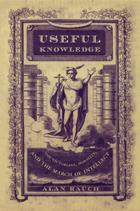 Useful Knowledge: The Victorians, Morality, and the March of Intellect
Alan Rauch
Duke University Press, 2001 Nineteenth-century England witnessed an unprecedented increase in the number of publications and institutions devoted to the creation and the dissemination of knowledge: encyclopedias, scientific periodicals, instruction manuals, scientific societies, children’s literature, mechanics’ institutes, museums of natural history, and lending libraries. In Useful Knowledge Alan Rauch presents a social, cultural, and literary history of this new knowledge industry and traces its relationships within nineteenth-century literature, ending with its eventual confrontation with Charles Darwin’s Origin of Species.
Rauch discusses both the influence and the ideology of knowledge in terms of how it affected nineteenth-century anxieties about moral responsibility and religious beliefs. Drawing on a wide array of literary, scientific, and popular works of the period, the book focusses on the growing importance of scientific knowledge and its impact on Victorian culture. From discussions of Jane Webb Loudon’s The Mummy! and Mary Shelley’s Frankenstein, to Charlotte Brontë’s The Professor, Charles Kingsley’s Alton Locke, and George Eliot’s Mill on the Floss, Rauch paints a fascinating picture of nineteenth-century culture and addresses issues related to the proliferation of knowledge and the moral issues of this time period. Useful Knowledge touches on social and cultural anxieties that offer both historical and contemporary insights on our ongoing preoccupation with knowledge.
Useful Knowledge will appeal to readers interested in nineteenth century history, literature, culture, the mediation of knowledge, and the history of science.
 Useful Optics
Walter T. Welford
University of Chicago Press, 1991 Students and professionals alike have long felt the need of a modern source of practical advice on the use of optical tools in scientific research. Walter T. Welford's Useful Optics meets this need.
Welford offers a succinct review of principles basic to the construction and use of optics in physics. His lucid explanations and clear illustrations will particularly help those whose interests lie in other areas but who nevertheless must understand enough about optics to create the experimental apparatus necessary to their research. Consistently emphasizing applications and practical points of design, Welford covers a host of topics: mirrors and prisms, optical materials, aberration, the limits of image formation and resolution, illumination for image-forming systems, laser beams, interference and interferometry, detectors and light sources, holography, and more. The final chapter deals with putting together an experimental optics system.
Many areas of the physical sciences and engineering increasingly demand an appreciation of optics. Welford's Useful Optics will prove indispensable to any researcher trying to develop and use effective optical apparatus.
Walter T. Welford (1916-1990) was professor of physics at Imperial College of Science, Technology and Medicine from 1951 until his death. He was a Fellow of the Royal Society and of the Optical Society of America.
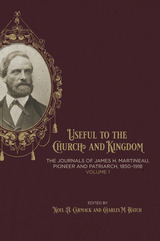 Useful to the Church and Kingdom: The Journals of James H. Martineau, Pioneer and Patriarch, 1850-1918, Volume: 1
Noel A. Carmack
Signature Books, 2023 After receiving a liberal arts education at the Munro Academy in Elbridge, New York, and a stint in the U.S.–Mexican War, James Henry Martineau spent his life as a surveyor, civil engineer, clerk, mapmaker, and pathfinder in Zion. After becoming a Latter-day Saint in 1850, Martineau went with Apostle George A. Smith to settle Parowan in southern Utah, with a commitment to building God’s kingdom in the West. As a leader in the Utah Territorial Militia he conducted military drills, witnessed events surrounding the Mountain Meadows Massacre and the legal trials of its perpetrators, explored wilderness areas, submitted reports, and drew maps to record his travels throughout the entire Mormon corridor.
These journals document his exploration of virgin lands in southern Utah, his laying out of townsites and farmland in Cache Valley, his participation in canal building and water projects in Arizona, and his near-death experiences while surveying rough, mountainous areas. His work for the Union Pacific Railroad through Weber Canyon and across the Salt Lake Promontory and Humboldt Desert in 1868 is one of the very few complete records of its kind.
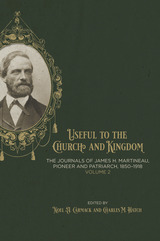 Useful to the Church and Kingdom: The Journals of James H. Martineau, Pioneer and Patriarch, 1850-1918, Volume: 2
Noel A. Carmack
Signature Books, 2023 After receiving a liberal arts education at the Munro Academy in Elbridge, New York, and a stint in the U.S.–Mexican War, James Henry Martineau spent his life as a surveyor, civil engineer, clerk, mapmaker, and pathfinder in Zion. After becoming a Latter-day Saint in 1850, Martineau went with Apostle George A. Smith to settle Parowan in southern Utah, with a commitment to building God’s kingdom in the West. As a leader in the Utah Territorial Militia he conducted military drills, witnessed events surrounding the Mountain Meadows Massacre and the legal trials of its perpetrators, explored wilderness areas, submitted reports, and drew maps to record his travels throughout the entire Mormon corridor.
These journals document his exploration of virgin lands in southern Utah, his laying out of townsites and farmland in Cache Valley, his participation in canal building and water projects in Arizona, and his near-death experiences while surveying rough, mountainous areas. His work for the Union Pacific Railroad through Weber Canyon and across the Salt Lake Promontory and Humboldt Desert in 1868 is one of the very few complete records of its kind.
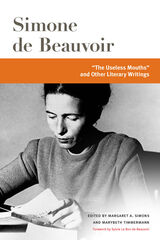 "The Useless Mouths" and Other Literary Writings
Simone de Beauvoir; Edited by Margaret A. Simons and Marybeth Timmermann; Foreword by Sylvie Le Bon de Beauvoir
University of Illinois Press, 2021 "The Useless Mouths" and Other Literary Writings brings to English-language readers literary writings--several previously unknown--by Simone de Beauvoir. Culled from sources including various American university collections, the works span decades of Beauvoir's career. Ranging from dramatic works and literary theory to radio broadcasts, they collectively reveal fresh insights into Beauvoir's writing process, personal life, and the honing of her philosophy. The volume begins with a new translation of the 1945 play The Useless Mouths, written in Paris during the Nazi occupation. Other pieces were discovered after Beauvoir's death in 1986, such as the 1965 short novel "Misunderstanding in Moscow," involving an elderly French couple who confront their fears of aging. Two additional previously unknown texts include the fragmentary "Notes for a Novel," which contains the seed of what she later would call "the problem of the Other," and a lecture on postwar French theater titled Existentialist Theater. The collection notably includes the eagerly awaited translation of Beauvoir's contribution to a 1965 debate among Jean-Paul Sartre and other French writers and intellectuals, "What Can Literature Do?" Prefaces to well-known works such as Bluebeard and Other Fairy Tales,La Bâtarde, and James Joyce in Paris: His Final Years are also available in English for the first time, alongside essays and other short articles. A landmark contribution to Beauvoir studies and French literary studies, the volume includes informative and engaging introductory essays by prominent and rising scholars. Contributors are Meryl Altman, Elizabeth Fallaize, Alison S. Fell, Sarah Gendron, Dennis A. Gilbert, Laura Hengehold, Eleanore Holveck, Terry Keefe, J. Debbie Mann, Frederick M. Morrison, Catherine Naji, Justine Sarrot, Liz Stanley, Ursula Tidd, and Veronique Zaytzeff.
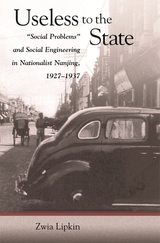 Useless to the State: “Social Problems” and Social Engineering in Nationalist Nanjing, 1927–1937
Zwia Lipkin
Harvard University Press, 2006 In 1911, Joseph Bailie, a professor at Nanjing University, often took his Chinese students to tour Nanjing's shantytowns. One student, the son of a district magistrate, followed Bailie from hut to hut one rainy day, and was grateful that Bailie opened his eyes to the poverty in his own city.
However, twenty years later, when M. R. Schafer, another Nanjing University professor, showed his students a film that included his own photographs of the poor quarters of Nanjing, his students were so upset that they demanded his expulsion from China.
Zwia Lipkin explores the reasons for these starkly different reactions. Nanjing in the 1910s was a quiet city compared to 1930s Nanjing, which was by that time the national capital. Nanjing had become a symbol of national authority, aiming not only to become a model of modernization for the rest of China, but also to surpass Paris, London, and Washington. Underlying all of Nanjing's policies was a concern for the capital's image and looks—offensive people were allowed to exist as long as they remained invisible.
Lipkin exposes both the process of social engineering and the ways in which the suppressed reacted to their abuse. Like Professor Schafer's movie, this book puts the poor at the center of the picture, defying efforts to make them invisible.
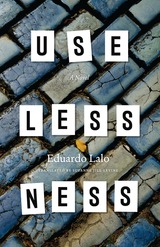 Uselessness: A Novel
Eduardo Lalo
University of Chicago Press, 2017 The streets of Paris at night are pathways coursing with light and shadow, channels along which identity may be formed and lost, where the grand inflow of history, art, language, and thought—and of love—can both inspire and enfeeble. For the narrator of Eduardo Lalo’s Uselessness, it is a world long desired. But as this young aspiring writer discovers upon leaving his home in San Juan to study—to live and be reborn—in the city of his dreams, Paris’s twinned influences can rip you apart.
Lalo’s first novel, Uselessness is something of a bildungsroman of his own student days in Paris. But more than this, it is a literary précis of his oeuvre—of themes that obsess him still. Told in two parts, Uselessness first follows our narrator through his romantic and intellectual awakenings in Paris, where he elevates his adopted home over the moribund one he has left behind. But as he falls in and out of love he comes to realize that as a Puerto Rican, he will always be apart. Ending the greatest romance of his life—that with the city of Paris itself—he returns to San Juan. And in this new era of his life, he is forced to confront choices made, ambitions lost or unmet—to look upon lives not lived.
A tale of the travails of youthful romance and adult acceptance, of foreignness and isolation both at home and abroad, and of the stultifying power of the desire to belong—and to be moved—Uselessness is here rendered into English by the masterful translator Suzanne Jill Levine. For anyone who has been touched by the disquieting passion of Paris, Uselessness is a stirring saga.
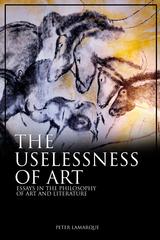 The Uselessness of Art: Essays in the Philosophy of Art and Literature
Peter Lamarque
Sussex Academic Press, 2022 No one denies that much art begins life with practical aims in mind: religious, moral, political, propagandistic, or the aggrandising of its subjects. But those works that survive the test of time will move into contexts where for new audiences any initial instrumental values recede and the works come to be valued "for their own sake." The book explores this idea and its ramifications. The glorious Palaeolithic paintings on the walls of the Chauvet Cave present a stark example. In spite of total ignorance of their original purposes, we irresistibly describe the paintings as works of art and value them as such. Here we are at the very limits of what is meant by "art" and "aesthetic appreciation." Are we misusing these terms in such an application? The question goes to the heart of the scope and ambition of aesthetics. Must aesthetics in its pursuit of art and beauty inevitably be culture-bound? Or can it transcend cultural differences and speak meaningfully of universal values: timelessly human, not merely historically relative? The case of literature or film puts further pressure on the idea of art valued "for its own sake." Characters in works of literature and film or finely-honed emotions in poetry often give pleasure precisely because they resonate with our own lives and seem (in the great works) to say something profound about human existence. Is not this kind of insight why we value such works? Yet the conclusion is not quite as clear-cut as it might seem, and the idea of valuing something "for its own sake" never quite goes away.
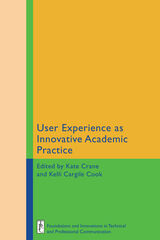 User Experience as Innovative Academic Practice
Kate Crane
University Press of Colorado, 2022 Situating itself in the Technical and Professional Communication discipline, this edited collection provides case studies from various points of instruction and curricular design to illustrate how a user experience (UX) methodology provides invaluable insight into understanding and including student-users. Drawing on research on student-users as they developed student-user profiles, journey maps, diary entries, course reflections, and affinity diagramming, among other sources, the authors of the chapters in this book argue that UX design is not only a worthy practice, but also a necessary one. Collectively, they argue that the UX design approach allows student-users to become co-creators of class material and academic products rather than the byproducts of such work. Together, the work in this collection offers an impetus of a new way of thinking about instruction and programs: designing courses and programs not only for students but with them.
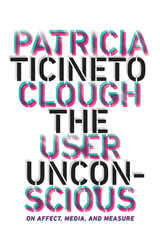 The User Unconscious: On Affect, Media, and Measure
Patricia Ticineto Clough
University of Minnesota Press, 2018 Wide-ranging essays and experimental prose forcefully demonstrate how digital media and computational technologies have redefined what it is to be human
Over the past decade, digital media has expanded exponentially, becoming an essential part of daily life. The stimulating essays and experimental compositions in The User Unconscious delve into the ways digital media and computational technologies fundamentally affect our sense of self and the world we live in, from both human and other-than-human perspectives. Critical theorist Patricia Ticineto Clough’s provocative essays center around the motif of the “user unconscious” to advance the challenging thesis that that we are both human and other-than-human: we now live, think, and dream within multiple layers of computational networks that are constantly present, radically transforming subjectivity, sociality, and unconscious processes. Drawing together rising strains of philosophy, critical theory, and media studies, as well as the political, social, and economic transformations that are shaping the twenty-first-century world, The User Unconscious points toward emergent crises and potentialities in both human subjectivity and sociality. Moving from affect to data, Clough forces us to see that digital media and computational technologies are not merely controlling us—they have already altered what it means to be human.
User-Centric Privacy and Security in Biometrics
Claus Vielhauer
The Institution of Engineering and Technology, 2018 The interplay of privacy, security and user-determination is an important consideration in the roll-out of biometric technologies. It brings into play requirements such as privacy of biometric data in systems, communication and databases, soft biometric profiling, biometric recognition of persons across distributed systems and in nomadic scenarios, and the convergence between user convenience, usability and authentication reliability.
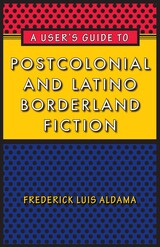 A User's Guide to Postcolonial and Latino Borderland Fiction
By Frederick Luis Aldama
University of Texas Press, 2009 Why are so many people attracted to narrative fiction? How do authors in this genre reframe experiences, people, and environments anchored to the real world without duplicating "real life"? In which ways does fiction differ from reality? What might fictional narrative and reality have in common—if anything? By analyzing novels such as Arundhati Roy's The God of Small Things, Amitav Ghosh's The Glass Palace, Zadie Smith's White Teeth, and Hari Kunzru's The Impressionist, along with selected Latino comic books and short fiction, this book explores the peculiarities of the production and reception of postcolonial and Latino borderland fiction. Frederick Luis Aldama uses tools from disciplines such as film studies and cognitive science that allow the reader to establish how a fictional narrative is built, how it functions, and how it defines the boundaries of concepts that appear susceptible to limitless interpretations. Aldama emphasizes how postcolonial and Latino borderland narrative fiction authors and artists use narrative devices to create their aesthetic blueprints in ways that loosely guide their readers' imagination and emotion. In A User's Guide to Postcolonial and Latino Borderland Fiction, he argues that the study of ethnic-identified narrative fiction must acknowledge its active engagement with world narrative fictional genres, storytelling modes, and techniques, as well as the way such fictions work to move their audiences.
 A User's Guide to the Age of Tech
Grant Wythoff
University of Minnesota Press, 2025 How users experience and influence technological change—when so much of that change feels out of our control Every day, we casually employ one of the most complex tools ever created, using it to read the news, plan our day, and connect with friends. In A User’s Guide to the Age of Tech, Grant Wythoff investigates the process by which now-ubiquitous technologies like our phones become integrated into our lives, showing how the “gadget” stage—before devices are widely adopted—opens the door for users to co-create these technologies and adapt them toward unexpected ends. In this elegant, approachable work, Wythoff offers a view of how users make new technology their own, subverting dominant power structures and imagining uses never intended by their creators. Rooted in a detailed look into the history of technique (focusing on how we do things with tools rather than the tools themselves), A User’s Guide to the Age of Tech proceeds to complicate, and influence, discussion of subjects like the digital divide and AI. Drawing on a range of sources, including novels, patents, and newspapers, Wythoff explores the vernacular philosophies that have emerged from users and their diverse, everyday practices, bringing down to earth the conversation about digital titans, away from the abstracted domains of server farms and algorithms. Lodging a passionate argument that we know ourselves better than the data brokers who appear to wield influence over our psyches, Wythoff invites readers (and tech users) to imagine their own digital technique, acknowledge their vast expertise, and see its immense value. Retail e-book files for this title are screen-reader friendly with images accompanied by short alt text and/or extended descriptions.
 A User's Guide to the Crisis of Civilization: And How to Save It
Nafeez Mosaddeq Ahmed
Pluto Press, 2010 It often seems that different crises are competing to devastate civilisation. This book argues that financial meltdown, dwindling oil reserves, terrorism and food shortages need to be considered as part of the same ailing system.
Most accounts of our contemporary global crises such as climate change, or the threat of terrorism, focus on one area, or another, to the exclusion of others. Nafeez Mosaddeq Ahmed argues that the unwillingness of experts to look outside their own fields explains why there is so much disagreement and misunderstanding about particular crises. This book attempts to investigate all of these crises, not as isolated events, but as trends and processes that belong to a single global system. We are therefore not dealing with a 'clash of civilisations', as Huntington argued. Rather, we are dealing with a fundamental crisis of civilisation itself.
This book provides a stark warning of the consequences of failing to take a broad view of the problems facing the world and shows how catastrophe can be avoided.
A User's Guide to the Nestle-Aland 28 Greek New Testament
David Trobisch
SBL Press, 2013 This guide introduces the complex new edition of the Nestle-Aland Novum Testamentum Graece, 28 Edition, explaining its structure, the text-critical apparatus and appendices, and the innovations of the new edition.
 Uses and Abuses of Moses: Literary Representations since the Enlightenment
Theodore Ziolkowski
University of Notre Dame Press, 2016 In Uses and Abuses of Moses, Theodore Ziolkowski surveys the major literary treatments of the biblical figure of Moses since the Enlightenment. Beginning with the influential treatments by Schiller and Goethe, for whom Moses was, respectively, a member of a mystery cult and a violent murderer, Ziolkowski examines an impressive array of dramas, poems, operas, novels, and films to show the many ways in which the charismatic figure of Moses has been exploited—the “uses and abuses” of the title—to serve a variety of ideological and cultural purposes.
Ziolkowski’s wide-ranging and in-depth study compares and analyzes the attempts by nearly one hundred writers to fill in the gaps in the biblical account of Moses’ life and to explain his motivation as a leader, lawgiver, and prophet. As Ziolkowski richly demonstrates, Moses’ image has been affected by historical factors such as the Egyptomania of the 1820s, the revolutionary movements of the mid-nineteenth century, the early move toward black liberation in the United States, and critical biblical scholarship of the late nineteenth century before, in the twentieth century, being appropriated by Marxists, Socialists, Nazis, and Freudians. The majority of the works studied are by Austro-German and Anglo-American writers, but Ziolkowski also includes significant examples of works from Hungary, Sweden, Norway, the Ukraine, Denmark, the Netherlands, Italy, and France. The figure of Moses becomes an animate seismograph, in Ziolkowski’s words, through whose literary reception we can trace many of the shifts in the cultural landscape of the past two centuries.
"With Uses and Abuses of Moses: Literary Representations since the Enlightenment, Theodore Ziolkowski has delivered a magisterial account of the history of uses of Moses. Professor Ziolkowski is the preeminent interpreter of how the Bible has been received by and has shaped modern literature; this book demonstrates an encyclopedic breadth of vision as well as a concise and convincing assessment of significance. I can't think of any literary scholar who manages to combine so successfully a comprehensive view of a vast literary landscape, incisive judgment, and crisp, enjoyable prose." —John Barbour, St. Olaf College
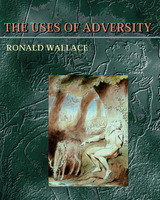 Uses Of Adversity
Ronald Wallace
University of Pittsburgh Press, 2008 The Uses of Adversity— titled after the line from As You Like It, “Sweet are the uses of adversity” - is a collection of one hundred sonnets cobining the craftiness of traditional form with the effortlessness of free verse. The language is often richly textured and musical, often plain spoken and conversational, but always witty and accessible. The subject matter ranges widely from Rootie Kazootie and Froggy the Gremlin, Howdy Doody and Elvis Presley, to Christopher Columbus, Khrushchev, Kennedy, and Kevorkian; from Donald Duck, Mandrake the Magician, Li’l Abner and the Creature from the Black Lagoon, to Shakespeare, H.P. Lovecraft, Transtromer, Rilke, Wittgenstein, and Nietzsche; from the tradtional themes of lyrics - love (both sacred and profane), death, the changing of the seasons, marriage, birth, divorce, childhood, sex, religion,art, the natural world, illness - to the most unexpected and quirky contemporary narratives.
The title sequence, which explores a father’s illness and death, is both elegiac and celebratory, evoking the conflictual bonds in any father-son relationship. In these sonnets, by turns hilarious and heartbreaking, Wallace once again proves himself to be one of our most versatile and affirmative poets.
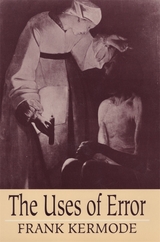 The Uses of Error
Frank Kermode
Harvard University Press, 1991 “The history of interpretation, the skills by which we keep alive in our minds the light and dark of past literature and past humanity, is to an incalculable extent a history of error.” So writes Frank Kermode of a history to which he has contributed many luminous pages. This book is a record of Kermode’s “error,” his wandering through literature past and present. He notes that “in thirty-odd years I have written several hundred reviews, an example I would strongly urge the young not to follow.” From these hundreds Kermode has selected the pieces he treasures most, and they provide an example that indeed will be difficult to follow.
The Uses of Error contains some of Kermode’s very best writing. Again and again he proves himself to be more than a commentator or chronicler; he is rather a creator of cultural value in his interaction with the texts at hand. The appeal of this book is broad. Everything is here from Augustine to Ariès on death and dying, from Wilde to Woolf and writer’s block, from Joachim of Fiore to Flaubert’s Parrot. In a phrase or an aside on any of these subjects Kermode can open a vista, wither a reputation, or spotlight an intellectual mantrap.
The core of the volume is a group of essays on the central figures of modern English literature. Kermode tells more here—about Tennyson, Shaw, Forster, and Eliot—than most people could in twice the space. His brief, vivid, and sympathetic writings extol the range of British writing and mark out the difference between an interest that is solely academic and the richer view of one who writes from inside the culture and shares a common experience with its interpreters.
There is also Kermode the man. He saves a set of autobiographical essays until the end, and they are a veritable dessert for those who read the volume straight through. But they will stand first in the reader’s memory afterward, because they give body to the mind so clearly in evidence throughout the book. Kermode shows us the means by which he gained the perspective to become a transnational critic—not a critic on the margin, but one who shows us where the margins are. For anyone who is not yet familiar with Frank Kermode’s work, this is the place to begin. For those who are already acquainted with it, here is the chance to see the pattern of the whole.
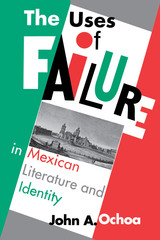 The Uses of Failure in Mexican Literature and Identity
By John A. Ochoa
University of Texas Press, 2005 While the concept of defeat in the Mexican literary canon is frequently acknowledged, it has rarely been explored in the fullness of the psychological and religious contexts that define this aspect of "mexicanidad." Going beyond the simple narrative of self-defeat, The Uses of Failure in Mexican Literature and Identity presents a model of failure as a source of knowledge and renewed self-awareness. Studying the relationship between national identity and failure, John Ochoa revisits the foundational texts of Mexican intellectual and literary history, the "national monuments," and offers a new vision of the pivotal events that echo throughout Mexican aesthetics and politics. The Uses of Failure in Mexican Literature and Identity encompasses five centuries of thought, including the works of the Conquistador Bernal Díaz del Castillo, whose sixteenth-century True History of the Conquest of New Spain formed Spanish-speaking Mexico's early self-perceptions; José Vasconcelos, the essayist and politician who helped rebuild the nation after the Revolution of 1910; and the contemporary novelist Carlos Fuentes. A fascinating study of a nation's volatile journey towards a sense of self, The Uses of Failure elegantly weaves ethical issues, the philosophical implications of language, and a sociocritical examination of Latin American writing for a sparkling addition to the dialogue on global literature.
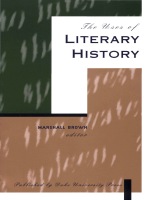 The Uses of Literary History
Marshall Brown, ed.
Duke University Press, 1995 In this collection, Marshall Brown has gathered essays by twenty leading literary scholars and critics to appraise the current state of literary history. Representing a range of disciplinary specialties and approaches, these essays illustrate and debate the issues that confront scholars working on the literary past and its relation to the present. Concerned with both the theory and practice of literary history, these provocative and sometimes combative pieces examine the writing of literary history, the nature of our interest in tradition, and the ways that literary works act in history. Among the numerous issues discussed are the uses of evidence, anachronism, the dialectic of texts and contexts, particularism and the resistance to reductive understanding, the construction of identities, memory, and the endurance of the past. New historicism, nationalism, and gender studies appear in relation to more traditional issues such as textual editing, taste, and literary pedagogy. Combining new and old perspectives, The Uses of Literary History provides a broad view of the field. Contributors. Charles Altieri, Jonathan Arac, R. Howard Bloch, Richard Dellamora, Paul H. Fry, Geoffrey Hartman, Denis Hollier, Donna Landry, Lawrence Lipking, Jerome J. McGann, Walter Benn Michaels, Rukmini Bhaya Nair, Virgil Nemoianu, Annabel Patterson, David Perkins, Marjorie Perloff, Meredith Anne Skura, Doris Sommer, Peter Stallybrass, Susan Stewart
Uses of Literature
Monroe Engel
Harvard University Press “The life of a literary work depends on readers whose existence it confirms or (the valuable possibility) augments,” writes Monroe Engel. The essays collected here concern the related thesis that “the vitality of the literary enterprise is related to its usability, its capacity to strengthen or alter our options.” The first group of essays is theoretical—discussion of habit, originality, religious perspectives, and self-evaluation. The second group approaches specific issues and authors within the American context. The collection concludes with five essays on teaching literature to students whose previous literary exposure has been limited.
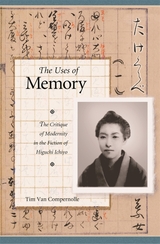 The Uses of Memory: The Critique of Modernity in the Fiction of Higuchi Ichiyō
Timothy J. Van Compernolle
Harvard University Press, 2006 The pioneering writer Higuchi Ichiyō (1872–1896) has been described as “the last woman of old Japan,” a consummate stylist of classical prose, whose command of the linguistic and rhetorical riches of the premodern tradition might suggest that her writings are relics of the past with no concern for the problems of modern life.
Timothy Van Compernolle investigates the social dimensions of Ichiyō’s artistic imagination and argues that she creatively reworked the Japanese literary tradition in order to understand, confront, and critique the emerging modernity of the Meiji period. For Ichiyō, the classical canon was a reservoir of tropes and paradigms that could be reshaped and renewed as a way to explore the sociopolitical transformations of the 1890s and cast light upon the human costs of modernization.
Drawing critical momentum from the dialogical theory of Mikhail Bakhtin, the author explores in five of Ichiyō’s best known stories how traditional rhetoric and literary devices are dialogically engaged with discourses associated with modernity within the pages of Ichiyō’s narratives. In its close, sensitive readings of Ichiyō’s oeuvre, The Uses of Memory not only complicates the scholarly discussion of her position in the Japanese literary canon, but also broaches larger theoretical issues.
The Uses of Oppression: The Ottoman Empire through Its Greek Newspapers, 1830–1862
Marina Sakali, Lady Marks
Harvard University Press, 2024 During the middle decades of the nineteenth century, a generation of Ottoman Greeks was caught up in radical social and political changes, including the period of reforms known as Tanzimat. The Ottoman Greek press was both a product and an agent of these changes. The Uses of Oppression follows the development of the Ottoman Greek press from its birth in 1830 until 1862, employing the vivid reflections of its editors, correspondents, advertisers, commentators, and readers as a lens through which to view the everyday lives of this generation of Ottoman Greeks—their social aspirations, their reactions to political events, their reception of Western-style norms, and other contemporary issues.
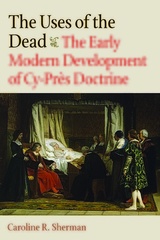 The Uses of the Dead
Caroline R. Sherman
Catholic University of America Press, 2017 Cy-près doctrine, which allows the purpose of a failing or impractical charitable gift to be changed, has been understood since the eighteenth century as a medieval canon law principle, derived from Roman law, to rescue souls by making good their last charitable intentions. The Uses of the Dead offers an alternate origin story for this judicial power, grounded in modern, secular concerns.
Posthumous gifts, which required no sacrifice during life, were in fact broadly understood by canon lawyers and medieval donors themselves to have at best a very limited relationship to salvation. As a consequence, for much of the Middle Ages the preferred method for resolving impossible or impractical gifts was to try to reach a consensus among all of the interested parties to the gift, including the donor's heirs and the recipients, with the mediation of the local bishop.
When cy-près emerged in the seventeenth century, it cut a charitable gift o from return to the donor's estate in the event of failure. It also gave the interested parties to the gift (heirs, beneficiaries, or trustees) little authority over resolutions to problematic gifts, which were now considered primarily in relationship to the donor's intent—even as the intent was ultimately honored only in its breach. The Uses of the Dead shows how cy-près developed out of controversies over church property, particularly monastic property, and whether it might be legally turned over to fund education, poor relief, or national defense.
Renaissance humanists hoped to make better, more prudent uses of property; the Reformation sought to correct superstitious abuses of property and ultimately tended to prevent donors' heirs from recovering secularized ecclesiastical gifts; and the early modern state attempted to centralize poor relief and charitable efforts under a more rational, centralized supervision. These three factors combined to replace an older equitable ideal with a new equitable rule—one whose use has rapidly expanded in the modern era to allow assorted approximations and judicial redistributions of property.
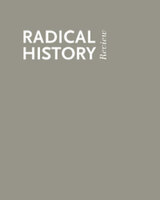 Uses of the Folk, Volume 2002
Karl Hagstrom Miller and Ellen Noonan, eds.
Duke University Press The Uses of the Folk introduces a new way of understanding the relationship between artists and populations designated as "the folk" and the scholars who define them. The issue begins with the premise that vernacular culture is an important tool through which communities assert their interests and identities within national and international politics. More than simply protecting or preserving traditions in the face of modernization, folk culture—and state or academic interest in it—gives many practitioners a rare but powerful voice within debates about modernity, national identity, and culture from which they have typically been barred. Folk communities often show a profound willingness to change the presentation of the culture in order to gain maximum advantage from authorities needed for authenticating power. The essays explore a variety of incarnations of "the folk," from the contested meanings of folk dance in creating a national culture in twentieth-century Haiti and Nicaragua, to the ways that the London Museum’s collection of artifacts challenged early-twentieth-century British notions of gender, labor, and citizenship, to the production of urban folklore in New York City. The Uses of the Folk identifies folk culture of the past and present as an important site of ongoing struggle—one affecting all scholars who draw on folk or vernacular culture in their work. Contributors. Adina Back, Jordanna Bailkin, Regina Bendix, Katherine Borland, Sally Charnow, Peggy P. Hargis, Georgina Hickey, John Howard, Shafali Lal, R. J. Lambrose, Ronald Radano, Kate Ramsey, Gerald Shenk, David Takacs, David Waldstreicher, Daniel Walkowitz, Steve Zeitlin
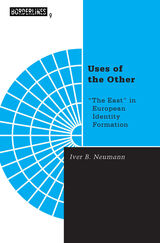 Uses Of The Other: “The East” in European Identity Formation
Iver B. Neumann
University of Minnesota Press, 1998 Examines identity politics in the context of international relations. The field of international relations has recently witnessed a tremendous growth of interest in the theme of identity and its formation, construction, and deconstruction. In Uses of the Other, Iver B. Neumann demonstrates how thinking about identity in terms of the self and other may prove highly useful in the study of world politics. Neumann begins by tracing the four different paths along which this thinking has developed during this century-ethnographic, psychological, Continental philosophical, and “Eastern excursion”-and he shows how these blended at the margins of the discipline of international relations at the end of the 1980s. There follow several incisive readings of European identity formations on the all-European, regional, and national levels. The theme that draws these readings together is how “the East” is used as a sign of otherness at all three levels. Whereas previous studies framed this process as part of colonial and postcolonial developments, this book suggests that “Easternness” is also present as a marker in contemporary discourses about Russia, Turkey, Central Europe, and Bashkortostan, among others. Situating his work in contemporary critical debates, Neumann argues that, while the self/other perspective is always of relevance, it is now more in need of being used as a perspective on specific sequences of identity formation than of further embellishment.ISBN: 0-8166-3082-8 Cloth $49.95xxISBN: 0-8166-3083-6 Paper $19.95x248 Pages 5-7/8x9 NovemberBorderlines Series, Volume 9Translation inquiries:
The Uses of the University: Fifth Edition
Clark Kerr
Harvard University Press, 1982 America's university president extraordinaire adds a new chapter and preface to The Uses of the University, probably the most important book on the modern university ever written. This summa on higher education brings the research university into the new century.
The multiversity that Clark Kerr so presciently discovered now finds itself in an age of apprehension with few certainties. Leaders of institutions of higher learning can be either hedgehogs or foxes in the new age. Kerr gives five general points of advice on what kinds of attitudes universities should adopt. He then gives a blueprint for action for foxes, suggesting that a few hedgehogs need to be around to protect university autonomy and the public weal.
The Uses of Tradition: Jewish Continuity in the Modern Era
Jack Wertheimer
Harvard University Press, 1992 How have modern Jews appropriated traditional aspects of their culture and religion to sustain them in the modern world? Twenty-one distinguished scholars address this question by drawing on a range of disciplines: social and cultural history, ethnography, folklore, sociology, educational theory, and rabbinics. They examine Jewish communities from Russia to North Africa, from Israel to the United States. Among the subjects they explore are Jewish art, holiday practices, feminist ceremonies, adult education, and religious movements in Israel.
The Uses of Tradition demonstrates the persistence of tradition and the limits to continuity. It asks: How extensively can tradition be reinterpreted before it is subverted? At what point is creative reinvention an act of betrayal? How effectively can selective borrowing from tradition sustain a religious community?
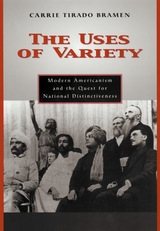 The Uses of Variety: Modern Americanism and the Quest for National Distinctiveness
Carrie Tirado Bramen
Harvard University Press, 2000 The turn of the last century, amid the excesses of the Gilded Age, variety became a key notion for Americans—a sign of national progress and development, reassurance that the modern nation would not fall into monotonous dullness or disorderly chaos. Carrie Tirado Bramen pursues this idea through the works of a wide range of regional and cosmopolitan writers, journalists, theologians, and politicians who rewrote the narrative of American exceptionalism through a celebration of variety. Exploring cultural and institutional spheres ranging from intra-urban walking tours in popular magazines to the 1893 World's Parliament of Religions in Chicago, she shows how the rhetoric of variety became naturalized and nationalized as quintessentially American and inherently democratic. By focusing on the uses of the term in the work of William James, Anna Julia Cooper, W. E. B. Du Bois, Hamlin Garland, and Wong Chin Foo, among many others, Bramen reveals how the perceived innocence and goodness of variety were used to construct contradictory and mutually exclusive visions of modern Americanism.
Bramen's innovation is to look at the debates of a century ago that established diversity as the distinctive feature of U.S. culture. In the late-nineteenth-century conception, which emphasized the openness of variety while at the same time acknowledging its limits, she finds a useful corrective to the contemporary tendency to celebrate the United States as a postmodern melange or a carnivalesque utopia of hybridity and difference.
Use-Wear Analysis of Flaked Stone Tools
Patrick C. Vaughan
University of Arizona Press, 1985 This major contribution to archaeological method details the use-wear analysis of a set of stone tools recovered during the excavation of Cassegros Cave, in southwestern France. The study combines low-power and high-power microwear approaches and develops their potential for use on a wider range of lithic and contact materials than have been reported previously.
 Ushering Civil Rights into Law: Judge Richard T. Rives and Desegregation in the Public Sphere
Pat Arneson
University of Alabama Press, 2026 Illuminates the life and legacy of a federal jurist from Alabama, an unexpected but ardent defender of equal rights for all citizens under the law Ushering Civil Rights into Law: Judge Richard T. Rives and Desegregation in the Public Sphere by Pat Arneson is a long-overdue exploration of one of the most consequential yet overlooked figures of the modern Civil Rights Movement. As debates over judicial philosophy and Civil Rights continue, Judge Richard T. Rives’s story serves as a powerful reminder of the judiciary’s role in shaping a more just society. A native of Montgomery, Alabama, Judge Richard T. Rives served on the US Court of Appeals for the Fifth Circuit during the height of America’s battle over racial segregation. Once aligned with segregationist views, Rives underwent a profound evolution, emerging as a key legal architect of desegregation. His landmark ruling on behalf of the court in Browder v. Gayle ended segregation on Montgomery’s public buses and expanded the scope of Brown v. Board of Education beyond education. Rives’s decisions invalidated the legal underpinnings of Jim Crow laws and furthered equality in public education, voting rights, and jury selection. Writing for the court, Rives authored legal precedents that fundamentally reshaped the nation. Through archival research, Arneson examines the cultural and political pressures Rives faced, the legal strategies he employed, and the lasting impact of his work. Constitutional rights remain a flashpoint in American discourse. Ushering Civil Rights into Law reveals how one judge’s principled stance helped define the legal landscape of modern Civil Rights and underscores the enduring significance of his legacy.
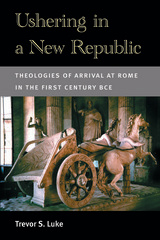 Ushering in a New Republic: Theologies of Arrival at Rome in the First Century BCE
Trevor S. Luke
University of Michigan Press, 2014 The ancient Romans are well known for their love of the pageantry of power. No single ceremony better attests to this characteristic than the triumph, which celebrated the victory of a Roman commander through a grand ceremonial entrance into the city that ended in rites performed to Rome’s chief tutelary deity, Jupiter Optimus Maximus, on the Capitoline hill. The triumph, however, was only one form of ceremonial arrival at the city, and Jupiter was not the only god to whom vows were made and subsequently fulfilled at the end of a successful assignment. Ushering in a New Republic expands our view beyond a narrow focus on the triumph to look at the creative ways in which the great figures of Rome in the first century BCE (men such as Sulla, Caesar, Augustus, and others) crafted theological performances and narratives both in and around their departures from Rome and then returned to cast themselves in the role of divinely supported saviors of a faltering Republic. Trevor S. Luke tackles some of the major issues of the history of the Late Republic and the transition to the empire in a novel way. Taking the perspective that Roman elites, even at this late date, took their own religion seriously as a way to communicate meaning to their fellow Romans, the volume reinterprets some of the most famous events of that period in order to highlight what Sulla, Caesar, and figures of similar stature did to make a religious argument or defense for their actions. This exploration will be of interest to scholars of religion, political science, sociology, classics, and ancient history and to the general history enthusiast. While many people are aware of the important battles and major thinkers of this period of Roman history, the story of its theological discourse and competition is unfolded here for the first time.
Using and Curating Archaeological Collections
S. Terry Childs
University Press of Colorado, 2019 All archaeologists have responsibilities to support the collections they produce, yet budgeting for and managing collections over the length of a project and beyond is not part of most archaeologists’ training. While this book in the SAA Press Archaeology in Action Series highlights major challenges that archaeologists and curators face with regard to collections, it also stresses the values, uses, and benefits of collections. It also demonstrates the continued significance of archaeological collections to the profession, tribes, and the public and provides critical resources for archaeologists to carry out their responsibilities. Many lament that the archaeological record is finite and disappearing. In this context, collections are even more important to preserve for future use, and this book will help all stakeholders do so.
Using Art as Research in Learning and Teaching: Multidisciplinary Approaches Across the Arts
Edited by Ross Prior
Intellect Books, 2018 Using Art as Research in Learning and Teaching explores various multidisciplinary visual and performing art forms, including creative writing, as ways to provide a rich contribution and understanding to research, learning, and teaching. Key figures in the field share their art-based research, arts practice, and philosophy, bringing the arts to life within their taught and learned contexts across a variety of art forms and levels of post-compulsory education. Featuring a foreword by internationally-renowned proponent of art-based research Professor Shaun McNiff, this book will be informative and useful to arts researchers and educators, addressing key challenges and possibilities in a rapidly changing higher education environment.
Using Biography
William Empson
Harvard University Press, 1984 Written in Empson's typically witty and iconoclastic style, Using Biography is a brilliant exploration of writers asdiverse as Marvell, Dryden, Fielding,Yeats, Eliot, and Joyce. The last book hecompleted before his death in 1984, itis his most recent since Milton's God waspublished in 1961. Empson's earlierbooks inspired American New Criticism,but unlike the New Critics Empson hasalways been an intentionalist. UsingBiography is dramatic evidence of hisfiercely held view that biographical material can help us appreciate a writer'smethods and intentions. It demonstratesa shrewd understanding of human relationships as they occur, not always explicitly, in works of literature.
Using Commonplace Books to Enrich Medieval and Renaissance Courses
Sarah E. Parker
Arc Humanities Press, 2023 This book is a collection of essays offering a wide range of approaches to teaching with commonplace books. In the medieval period and beyond, commonplace books promoted a blend of excerpting, memorization, creative writing, and journaling, making them the analogue equivalent to modern-day digital journaling, bookmarking, and note-taking tools. Covering a variety of methods for introducing students to the medieval and Renaissance reading practice known as commonplacing, this volume provides instructors with concrete guidelines for using commonplace books as a teaching and learning tool. The enclosed essays provide a point of reference for best practices as well as concrete models for teaching and learning with commonplace books, helping instructors develop more student-centred, inclusive curricula.
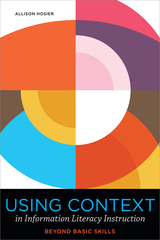 Using Context in Information Literacy Instruction: Beyond Basic Skills
Allison Hosier
American Library Association, 2022 Hosier shows academic librarians how to use context when teaching information literacy, an approach that offers a substantive and enduring impact on students' lifelong learning. Librarians know that information literacy is much more complex and nuanced than the basic library research skill that it's often portrayed as; in fact, as outlined by the ACRL Framework, research is a contextual activity. But the settings in which we teach often constrain our ability to take a more layered approach. This book not only shows you how to teach information literacy as something other than a basic skill, but also how to do it in whatever mode of teaching you’re most often engaged in, whether that's a credit-bearing course, a one-shot session, a tutorial, a reference desk interaction, or a library program. Taking you through each step of the research process, this book shares ideas for adding context while exploring topics such as - how conversations about context can be integrated into lessons on common information literacy topics;
- examples of the six genres of research and suggested course outlines for each;
- ensuring that context strategies fit within the ACRL Framework;
- questions for reflection in teaching each step of the research process;
- four different roles that sources can play when researching a topic;
- helping students refine a topic that is drawing too many or too few sources;
- cultivating students to become good decision-makers for the best type of research sources to use depending on their need; and
- how to address the shortcomings of checklist tools like the CRAAP test.
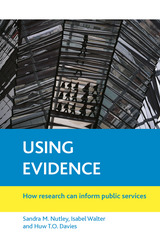 Using Evidence: How Research Can Inform Public Services
Sandra M. Nutley, Isabel Walter, and Huw T. O. Davies
Bristol University Press, 2007 This book provides a timely and novel contribution to understanding and enhancing evidence use. It builds on and complements the popular and best-selling "What Works?: Evidence-based policy and practice in public services" (Davies, Nutley and Smith, Policy Press, 2000), by drawing together current knowledge about how research gets used and how this can be encouraged and improved. In particular, the authors explore various multidiscipliary frameworks for understanding the research use agenda; consider how research use and the impact of research can be assessed; summarise the empirical evidence from the education, health care, social care and criminal justice fields about how research is used and how this can be improved and draw out practical issues that need to be addressed if research is to have greater impact on public services. "Using evidence" is important reading for university and government researchers, research funding bodies, public service managers and professionals, and students of public policy and management. It will also prove an invaluable guide for anyone involved in the implementation of evidence-based policy and practice.
Using Gramsci: A New Approach
Michele Filippini
Pluto Press, 2016 The notebooks kept by Antonio Gramsci while he was in prison in fascist Italy in the 1920s have been an inspiration to Marxist political thinkers and activists around the world for decades. With Using Gramsci, Michele Filippini teases out a number of previously ignored aspects of Gramsci’s works to create a book that stands apart from previous analyses. While Filippini does examine the aspects of Gramsci’s thought that have long attracted scholars—including his thinking on hegemony, organic intellectuals, and civil society—she foregrounds new concepts, including the individual, crisis, and space and time. The result is a rethinking of Gramsci for our era that offers a number of promising new ways forward.
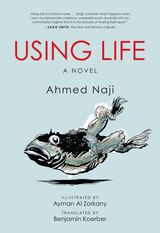 Using Life
By Ahmed Naji, Illustrations by Ayman Al Zorkany, Translated by Benjamin Koerber
University of Texas Press, 2017 Upon its initial release in Arabic in the fall of 2014, Using Life received acclaim in Egypt and the wider Arab world. But in 2016, Ahmed Naji was sentenced to two years in prison after a reader complained that an excerpt published in a literary journal harmed public morality. His imprisonment marks the first time in modern Egypt that an author has been jailed for a work of literature. Writers and literary organizations around the world rallied to support Naji, and he was released in December 2016. His original conviction was overturned in May 2017 but, at the time of printing, he is awaiting retrial and banned from leaving Egypt. Set in modern-day Cairo, Using Life follows a young filmmaker, Bassam Bahgat, after a secret society hires him to create a series of documentary films about the urban planning and architecture of Cairo. The plot in which Bassam finds himself ensnared unfolds in the novel’s unique mix of text and black-and-white illustrations. The Society of Urbanists, Bassam discovers, is responsible for centuries of world-wide conspiracies that have shaped political regimes, geographical boundaries, reigning ideologies, and religions. It is responsible for today’s Cairo, and for everywhere else, too. Yet its methods are subtle and indirect: it operates primarily through manipulating urban architecture, rather than brute force. As Bassam immerses himself in the Society and its shadowy figures, he finds Cairo on the brink of a planned apocalypse, designed to wipe out the whole city and rebuild anew.
Using Media for Social Innovation
Aneta Podkalicka and Ellie Rennie
Intellect Books, 2018 This book offers a critical road map for understanding and researching “social innovation media”—initiatives that look for new solutions to seemingly intractable social problems by combining creativity, media technologies, and engaged collectives in their design and implementation. Presenting a number of case studies, including campaigns dealing with young people, Indigenous peoples, human rights, and environmental issues, the book takes a close look at the guiding principles, assumptions, goals, practices, and outcomes of these experiments, revealing the challenges they face, the components of their innovation, and the cultural economy within which they operate.
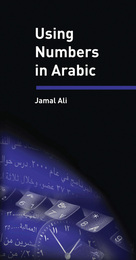 Using Numbers in Arabic
Jamal Ali
Georgetown University Press, 2013 Using Numbers in Arabic is an invaluable reference for the intermediate to advanced learner of Arabic. The proper use of numbers can often be perplexing for students of the Arabic language. While most Arabic grammars and textbooks include a chapter or discussion on the topic, that coverage is inadequate for serious students, scholars, and researchers. This guide shows the reader, using clear explanations and examples, exactly how to use cardinal and ordinal numbers in Arabic, from one to the billions and beyond. Each entry features a brief description in English followed by examples in Arabic from actual written and recorded texts; each example is also accompanied by an English translation. All information is based on real-world practice, with helpful citations from literature and media to illustrate each principle. In a second section, the author covers useful number-related topics, such as dates, times, fractions, decimals, and percentages, as well as basic arithmetic functions. While focusing on Modern Standard Arabic, the volume also covers Classical Arabic and describes and illustrates differences between classical and modern practice. The volume’s glossary, bibliography, and index will also be useful to students. Using Numbers in Arabic is a handy addition to the reference shelf of every serious student of the Arabic language, and it will be welcomed by native speakers with fluency in English interested in a reference on how to render numbers correctly.
Using Servant Leadership: How to Reframe the Core Functions of Higher Education
Letizia, Angelo J.
Rutgers University Press, 2018 Using Servant Leadership provides an instructive guide for how faculty members can engage in servant leadership with administrators, students, and community members. By utilizing a wide range of research and through a series of case studies, Angelo J. Letizia demonstrates how, with a bit of creative thinking, the ideals of servant leadership can work even in the fractious, cash-strapped world of contemporary higher education. Furthermore, he considers how these concepts can be implemented in pedagogy, research, strategic planning, accountability, and assessment. This book points the way to a more humane university, one that truly serves the public good.
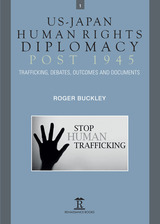 US-Japan Human Rights Diplomacy Post 1945: Trafficking, Debates, Outcomes and Documents
Roger Buckley
Amsterdam University Press, 2020 Comprising two volumes, this is a pioneering study which examines how the United States has deployed public diplomacy with Japan to confront Japanese sexual and labour trafficking, while also charting the successes and failures of the US’s own record on anti-trafficking practices at home and abroad. The subject is an important aspect of human rights advocacy where much remains either unknown or imprecise with regard to a phenomenon that involves millions of people across all continents and within all nation states. The approach is largely chronological and country-based, using documentary evidence from 1945 onwards to trace national and international responses to what is frequently termed ‘modern slavery’, placed within the broader and still evolving context of respect for the full panoply of human rights. Volume 1 comprises the analysis, debates and outcomes, together with ten primary documents relating to the years 1945–1999, as well as a bibliography and index. Volume 2 comprises a further 34 documents relating to the years 2000–2020, including international covenants, US Trafficking In Persons and Congressional reports, and Japanese government papers.
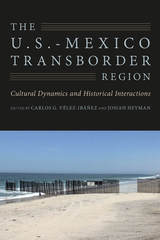 The U.S.-Mexico Transborder Region: Cultural Dynamics and Historical Interactions
Edited by Carlos G. Vélez-Ibáñez and Josiah Heyman
University of Arizona Press, 2017 The U.S.-Mexico Transborder Region presents advanced anthropological theorizing of culture in an important regional setting. Not a static entity, the transborder region is peopled by ever-changing groups who face the challenges of social inequality: political enforcement of privilege, economic subordination of indigenous communities, and organized resistance to domination. The book, influenced by the work of Eric Wolf and senior editor Carlos G. Vélez-Ibáñez, centers on the greater Mexican North/U.S. Southwest, although the geographic range extends farther. This tradition, like other transborder approaches, attends to complex and fluid cultural and linguistic processes, going beyond the classical modern anthropological vision of one people, one culture, one language. With respect to recent approaches, however, it is more deeply social, focusing on vertical relations of power and horizontal bonds of mutuality. Vélez-Ibáñez and Heyman envision this region as involving diverse and unequal social groups in dynamic motion over thousands of years. Thus the historical interaction of the U.S.-Mexico border, however massively unequal and powerful, is only the most recent manifestation of this longer history and common ecology. Contributors emphasize the dynamic “transborder” quality—conflicts, resistance, slanting, displacements, and persistence—in order to combine a critical perspective on unequal power relations with a questioning perspective on claims to bounded simplicity and perfection. The book is notable for its high degree of connection across the various chapters, strengthened by internal syntheses from notable border scholars, including Robert R. Alvarez and Alejandro Lugo. In the final section, Judith Freidenberg draws general lessons from particular case studies, summarizing that “access to valued scarce resources prompts the erection of human differences that get solidified into borders,” dividing and limiting, engendering vulnerabilities and marginalizing some people. At a time when understanding the U.S.-Mexico border is more important than ever, this volume offers a critical anthropological and historical approach to working in transborder regions. Contributors: Amado Alarcón
Robert R. Álvarez
Miguel Díaz-Barriga
Margaret E. Dorsey
Judith Freidenberg
Ruth Gomberg-Muñoz
James Greenberg
Josiah Heyman
Jane H. Hill
Sarah Horton
Alejandro Lugo
Luminiţa-Anda Mandache
Corina Marrufo
Guillermina Gina Núñez-Mchiri
Anna Ochoa O’Leary
Luis F. B. Plascencia
Lucero Radonic
Diana Riviera
Thomas E. Sheridan
Kathleen Staudt
Carlos G. Vélez-Ibáñez
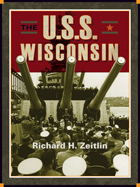 The USS Wisconsin: A History of Two Battleships
Richard H. Zeitlin
Wisconsin Historical Society Press, 1988 Battleships were instrumental in America’s rise to world dominance at the end of the 19th century. Two battleships in particular, the U.S.S. Wisconsin BB-9 and BB-64, participated in wars and conflicts around the globe, demonstrating America’s strength and technological power. The keel of the BB-9 was laid down on the eve of the Spanish-American War, and she sailed with the Great White Fleet on its famous world voyage of 1907-1909. Representing a major advance in American naval technology, the Wisconsin both demonstrated American strength in the Pacific and served as the setting for peace talks between Panama and Colombia when the former gained independence in 1903. Recommissioned during World War I as a training ship, the BB-9 was then decommissioned in 1920. More than twenty years later, on December 7, 1943, the fast battleship Wisconsin (BB-64) was launched in response to Japan’s attack on Pearl Harbor. The BB-64 served in the Pacific to the end of World War II and again in the Korean War. One of the Iowa- class battleships, the BB-64 was one of the fastest and sleekest on the ocean. In 1988, she was refitted and recommissioned for yet another tour of duty. This is the story of two proud vessels and their role in American naval and diplomatic history.
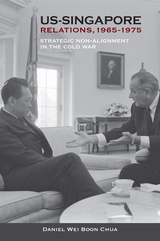 US-Singapore Relations, 1965-1975: Strategic Non-alignment in the Cold War
Daniel Wei Boon Chua
National University of Singapore Press, 2017 During the Vietnam War, the newly-independent Singapore struck the position of being non-aligned. It maintained an anti-communist stance while, at least initially, criticizing the United States’ intervention into Vietnam. Yet Singapore might not have achieved its post-colonial success so rapidly without the support of the United States. As the war in Vietnam raged on, Singapore became a critical refueling point, also providing ship and aircraft repair for the US military. Commercial and strategic support from the United States lifted Singapore out of the economic doom predicted for the city-state after secession from Malaysia. Without this strategic and economic assistance, Singapore’s history might have been different. By considering the importance of the role of the United States in Singapore’s nation-building, this book provides an important supplement to the well-trodden narrative that attributes Singapore’s success solely to good governance.
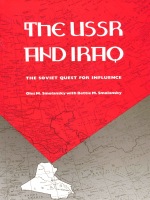 The USSR and Iraq: The Soviet Quest for Influence
Oles M. Smolansky, with Bettie M. Smolansky
Duke University Press, 1991 In The USSR and Iraq, the first major study of Soviet-Iraqi relations, Oles M. Smolansky examines the history of the relationship between these two countries during the past twenty years and attempts to dispel the misconception that the Soviet Union has enjoyed undue influence over Iraq.
Drawing on ten years of research in Western, Arab, and Soviet sources, Smolansky analyzes the complex issues at the center of Soviet-Iraqi relations from 1968 through 1988, including the nationalization of the oil industry, the Kurdish question, the Iraqi Communist Party, the affairs of the Persian/Arabian Gulf, and, ultimately, the war between Iraq and Iran.
Smolansky concludes that Iraq has never been under the dominant influence of Moscow, nor has it even been a loyal Soviet ally. In fact, Iraq has managed to reap major benefits from the relationship without losing its autonomy or sacrificing its major interests. The author discusses the Soviet Union and Iraq within the larger framework of the nature of influence relationships between great and small powers.
 Uta Barth: Peripheral Vision
Arpad Kovacs
J. Paul Getty Trust, The, 2023 This retrospective of the photographer Uta Barth traces her use of the camera to explore both how and what we see.
Los Angeles–based contemporary artist Uta Barth (b. 1958) has spent her decades-long career exploring the complexities and limits of human and mechanical vision. At first, her photographs appear to be deceptively simple depictions of everyday objects—light filtering through a window, tree branches bereft of leaves, a sparsely appointed domestic interior—but these images, visually spare yet conceptually rigorous, emerge from her investigation of sight, perception, light, and time.
In this richly illustrated monograph, curator Arpad Kovacs and contributors Lucy Gallun and Jeremy Gilbert-Rolfe chart Barth’s career path and discuss her most significant series, revealing how she has rejected the primacy of a traditional photographic subject and instead called attention to what is on the periphery. The book includes previously unpublished bodies of work made early in her career that add much to our understanding of this important artist. Also included is Barth’s most recent work, ...from dawn to dusk, an ambitious commission marking the twenty-fifth anniversary of the Getty Center.
Utah A People's History
Dean L May
University of Utah Press, 2002 History belongs to the people, Dean May reminds us, and must ultimately be accessible all. Based on his award-winning television series, Utah: A People's History provides a sweeping view of the state's past. From prehistory to present, May explains Utah as it is today and its promise for the future. The video series upon which this book is based is no longer available for sale.
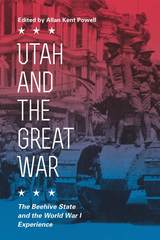 Utah and the Great War: The Beehive State and the World War I Experience
Edited by Allan Kent Powell
University of Utah Press, 2016 Copublished with the Utah State Historical Society. Affiliated with the Utah Division of State History, Utah Department of Heritage & Arts.
In time for the centennial of the United States’s entry into World War I, this collection of seventeen essays explores the war experience in Utah through multiple perspectives, from those of soldiers, nurses and ambulance drivers who experienced the horror of the conflict firsthand to those on the home front who were transformed by the war. Citizens supported the war financially, through service on councils of defense, with victory gardens, and by other means. Some of Utah’s Native Americans and at least one Episcopal bishop resisted the war. The terrible 1918–1919 flu pandemic impacted Utah and killed more victims around the world than those who died on the battlefields. There was a Red Scare and fight over United States participation in a League of Nations. These topics and more are explored, helping us understand the nature and complexity of the conflict and its impact on Utahns.
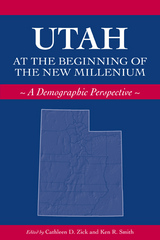 Utah at the Beginning of the New Millennium: A Demographic Perspective
Zick and Smith
University of Utah Press, 2006 To outsiders, the state of Utah often conjures many unsurprising stereotypes and images: Mormons, polygamy, large families, national parks, and skiing. Is there more to Utah and its residents than these generalizations? Few doubt that the religious institutions in Utah affect the state’s quality of life in many ways. But it is equally true that numerous features of the population are steadily and profoundly altering the very nature of Utah and its residents. This book describes the many fundamental demographic, social, and economic pressures that will likely alter the state’s path in the future.
Utah’s leading social scientists and population-related scholars draw on their specific areas of expertise and analyze Utah’s population using recent sources of data such as the 2000 U.S. Census. The chapters are organized into three broad topical sections: the foundations of Utah’s population (basic demographics), how the nature of the population affects our daily lives (quality of life issues), and the public policy challenges that will face Utah’s leaders (emerging issues).
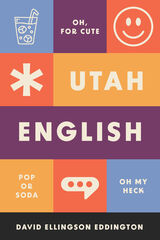 Utah English
David Ellingson Eddington
University of Utah Press, 2023 Is English in Utah truly unique? If so, what makes it different? Which stereotypes about how Utahns speak are completely off base and which are accurate? To answer these questions, linguist David Eddington surveyed more than 1,700 Utahns in an effort to better understand and systematize the peculiarities of English spoken in the Beehive State. This resulting book is a sophisticated data analysis that presents results in an accessible and often humorous fashion.
Utah is linguistically interesting for a variety of reasons. The massive numbers of immigrants who flocked there in the first years of European settlement, its relative isolation until completion of the transcontinental railroad, and its large Latter-day Saint population signaled greater linguistic commonality than is often the case in other western states. The book argues that religious affiliation, or lack thereof, might particularly play a role in the features that make up Utah English.
An accessible study of dialect in Utah, this book explores how social and geographic factors influence the pronunciations and regional expressions that characterize Utah English. Reflecting years of dealing with misconceptions about dialect both in and out of the classroom, Eddington covers vocabulary, individual words, syntax, vowels, and consonants, blending a serious and sometimes humorous approach to his research.
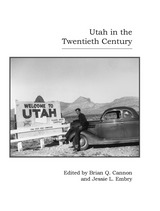 Utah in the Twentieth Century
Brian Q. Cannon and Jessie Embry
Utah State University Press, 2009 The twentieth century could easily be Utah's most interesting and complex. Utah in the Twentieth Century chronicles the social and cultural transitions of the time, offering a well-rounded perspective on the development and change the Beehive State went through during this period. It was an era complicated by the push of economic development and pull of traditional culture, demand for natural resources from a fragile and scenic environment, questions of who governs and how, who gets a vote, and who controls what on contested public lands, during which outside trade and a tourist economy increasingly challenged and fed an insular society. Activists left and right declaimed constitutional liberties while Utah's Native Americans become the last enfranchised in the nation. Proud contributions to national wars contrasted with denial of deep dependence on federal money; the skepticism of provocative writers, boosters eager for growth; and reflexive patriotism somehow bonded to ingrained distrust of federal government. A valuable resource for students and teachers, this work is also fruitful reading for anyone who desires to know more about key themes of Utah’s history in the twentieth century.
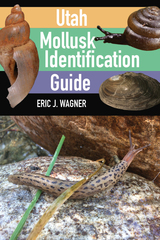 Utah Mollusk Identification Guide
Eric J. Wagner
University of Utah Press, 2022 The Utah Mollusk Identification Guide offers the latest information for identifying aquatic and terrestrial snails, slugs, clams, and mussels within the state of Utah, providing comparative tables, taxonomic keys, and more than 230 images, including many type specimen images published for the first time. Amateur naturalists and biologists alike will benefit from detailed information regarding size, type, specimen location, junior synonyms (including taxonomy notes), and original descriptions for each of the 139 species. Clarifying notes from the author help to differentiate similar species.
In contrast to older guides, this book includes data on the external and internal anatomy of mollusks and updated taxonomic names. Family descriptions and miscellaneous data on ecology, life history, and genetics offer readers a wide lens to understand Utah’s mollusks. Data based on historical articles, museum records, personal observations, and collections point to the wide distribution of mollusks found in Utah. Although the focus is on Utah mollusks, the data, images, references, and taxonomy details within the guide will be of interest to many outside the state.
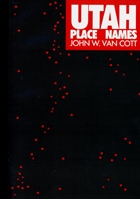 Utah Place Names: A Geopgraphic Guide to the Origins of Geographic Names, a Compilation
John Van Cott
University of Utah Press, 1991 Poverty Flat. Bearskin Gulch. Drunken Hollow. Soberville. Hogup Mountain. Lousy Jim Creek. Hey Hoe Canyon. Snake John Reef. Sob Rapids. Nipple Butte. Tooele. Laverskin. Skutumpah. All Utah toponyms, or place names. Where are they? What is their history? Their importance? Are they, or where they populated? Do they exist today? And always, The name. how did they get it? Who provided it? When? What does it mean? Is Centerville in the center, and of what? Was Notom named for a rejected suitor?
John W. Van Cott has spend the better part of a lifetime searching out the answers to these questions. Now the fruits of his labor are recorded in this, the most extensive compilation of Utah place names ever published. Almost five thousand toponyms are listed alphabetically, marking the passage of peoples and cultures from earliest times. Specialists will appreciate the geographical precision of Section, Township, Range, and altitude. Generalists will recognize counties and relationships to know features. All will delight in the rich lore, often a mixture of myth and history, of the place and its name. Scholars will find useful the inclusion of synonyms, nicknames, previous names, all cross-referenced, and all tied to a bibliography of over five hundred entries.
The author concluded his work of over forty years with the observation that he hardly touched the surface of Utah’s place names, numbered at over twenty-two thousand by the U.S. Geological Survey.
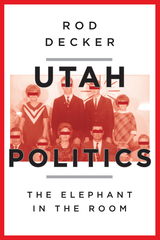 Utah Politics: The Elephant in the Room
Rod Decker
Signature Books, 2019 From the tempestuous fight for statehood to the evolution of Utah voters from Democrats to Republicans, Rod Decker analyzes the intersection of politics and faith in the complex political culture of modern Utah. Beginning with the state’s roots as a communal theocracy, Utah Politics deftly examines how Mormon morality influenced and continues to shape conflicts on both the local and federal levels. Whether determining the role nuclear fallout played in causing cancer epidemics throughout the state or the influence of Mormon lobbyists, Decker demonstrates how the rose that blossomed in the desert was sometimes fertilized by conspiracy, debate, and political machination.
Some themes reoccur: governors become popular by fighting federal oversight— signaling a lingering distrust that Washington could alter the Mormon way of life—and liberals use the court system to circumvent conservative legislatures who see public morality as a defining feature of government. Through this lens, issues both deceptively innocuous and deeply complex underscore Utah’s dance with religious freedom and civil liberty.
Utah Thirteeners
David M. Rose
University of Utah Press, 2004 Most Utahns are familiar with the Uinta Mountains, but few realize that the range has twenty-one peaks above 13,000 feet, some of them still unnamed. The elevation, challenging terrain and weather, solitude, and beautiful setting in Utah’s largest wilderness area make climbing these peaks a particularly rewarding experience. Better yet, in the summer and early fall every one of them can be climbed by a reasonably fit hiker without rope or climbing gear.
This guide provides detailed topographical maps and information on trailheads, access and summit routes with difficulty ratings, camp locations, estimated hiking times, weather, advice, and brief facts about geology and the history of the wilderness area. It also includes over fifty photographs of this breathtaking country.
Utah's Air Quality Issues: Problems and Solutions
Edited by Hal Crimmel
University of Utah Press, 2019 Although Utah is a land of outdoor wonders, the state has a distressing air pollution problem. In some areas like Salt Lake City, geography exacerbates the issue; air quality in the Wasatch Front metropolitan region often ranks among the worst in the nation.
Utah’s Air Quality Issues: Problems and Solutions is the first book to tackle the subject. Written by scholars in a variety of fields, including chemical engineering, economics, atmospheric science, health care, law, parks and recreation and public policy, the book provides a one-stop resource on the causes, impacts, and possible solutions to the state’s air quality dilemma. This volume is a must read for anyone wanting to understand Utah’s air pollution problem and what can be done about it.
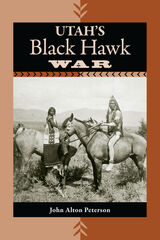 Utah'S Black Hawk War
John Alton Peterson
University of Utah Press, 1998 "On Sunday 9 April 1865, Ulysses S. Grant and Robert E. Lee met in the parlor of Wilmer McLean’s brick home in Appomattox Court House, Virginia, to negotiate the conclusion of the Civil War. That same day, far to the west, a handful of Mormons and northern Utes met in the central Utah town of Manti in an attempt to achieve a peace of their own. Unlike the negotiations at Appomattox, however, those in Manti failed, and the events that transpired there are viewed as the beginning of Utah’s Black Hawk War, the longest and most serious Indian-white conflict in Utah history."
—From the book So begins the story of Black Hawk, Ute Indian warrior chief and brilliant strategist, and Brigham Young, sagacious religious and political leader of the Mormons. Two powerful and unyielding men forged by hardship and conviction, both revered and both reviled in their times. One, orchestrating a remarkable campaign to turn back the tide of white expansion and prevent the extinction of his people, the other, attempting to keep his exiled church and its thriving utopian society sovereign and intact. Two men of distinct races, beliefs, and cultures, but sharing a determination to keep U.S. soldiers out of their bloody conflict for control of land and other resources in the Utah territory. From 1865 to 1867, the warrior Black Hawk, also known as Antonga, led a combined force of Utes, Navajos, and Paiutes in a series of intense stock raids on the Mormon settlements in Utah territory. Black Hawk astutely judged that political conflict between the federal government and Mormon Utah would keep U.S. soldiers from chastising his band. Moreover, the antagonism of Washington toward Utah’s polygamy, theocracy, and isolationism made Mormon leader Brigham Young wary of seeking federal help. In fact, to keep the government from using the war as a pretext for sending more troops to Utah, the Mormons withheld information, making the Black Hawk War an almost secret war as far as the rest of the nation was concerned. As directed by Brigham Young, Utah’s Latter-day Saint citizens mobilized a church militia, the Nauvoo Legion, to repel Indian attacks. Yet Black Hawk and others were able to carry on their activities for almost eight years without incurring the federal military reprisals that Indians on all four sides of the Mormon heartland experienced. Bloodshed on both sides plunged Mormons and Indians into a war of vengeance—years of killing and raiding that continued until federal troops stepped in 1872. In this unprecedented volume, historian John Peterson provides the first comprehensive analysis of a unique and compelling chapter of western history and of the violent and protracted conflict it engendered. Utah’s Black Hawk War not only explores political intricacies and broader implications, scrutinizing the Mormons' Indian policies—most notably Brigham Young’s extraordinary "better to feed them than fight them" teachings—but also presents vivid narrative accounts of various raids and battles. The result is a masterfully researched and engagingly written account of Utah’s secret war, a war largely unknown among western history students, scholars, and enthusiasts—until now.
Winner of the Mormon History Association Francis M. and Emily S. Chipman Best First Book Award.
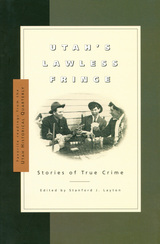 Utah's Lawless Fringe: Stories of True Crime
Stanford J. Layton
Signature Books, 2001 It was Sunday and worship service was in progress. One of the settlers who was not attending service eyed four known outlaws passing near town. He raced to church to spread the alarm, and parishioners leaped up, grabbed their guns, and galloped off in pursuit, joined by some neighboring cattlemen. Before it was over, one of the posse was dead.
So it went on the outskirts of Utah Territory. In this case it was the little town of Bluff where the Mormon bishop served for some ten years as de facto sheriff and his congregation as deputies. As elsewhere, law and order developed organically rather than by legislation.
In this anthology several aspects of the process are considered, including one of the worst manifestations of citizen action: vigilantism. Territorial Utah witnessed more lynchings than legal executions. Another citizen trait was an unexpected indifference to vice. In 1908 Salt Lake City had 148 registered prostitutes overseen by a madam who was recruited for the position by the mayor and city council. During Prohibition one of the largest distilleries in the West operated in a Salt Lake warehouse.
What is to be learned from this? The contributors to these fourteen articles leave moral considerations to the reader’s contemplation, while providing surprises along the way in an extremely engaging—dare we say arresting—read.
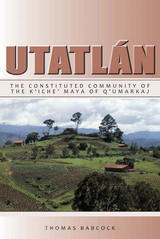 Utatlán: The Constituted Community of the K'iche' Maya of Q'umarkaj
Thomas F. Babcock
University Press of Colorado, 2012 One of the most important Postclassic cities, Utatlán, in highland Guatemala, was excavated more than three decades ago. However, the data amassed by archaeologists have not been published until now. Details on architecture, pottery, burials, and artifacts, along with a focus on residential archaeology, make Utatlán: The Constituted Community of the K'iche' Maya of Q'umarkaj a significant contribution to Maya archaeology.
Most information available on Utatlán focuses on the ceremonial center and ignores the city of the commoners. Using the archaeological data, Utatlán attempts to determine the boundaries of the community and to characterize subdivisions within it. Evidence of indigenous nonelite houses, rich burials, and grave goods unlike those found in contemporary sites reveals information about the supporting residence zone. In addition, Babcock applies the concept of "constituted community," interpreting the archaeological data from a prehistoric context, and proposes a theoretical framework for interpreting prehistoric sites with respect to urbanism and political complexity.
Utatlán: The Constituted Community of the K'iche' Maya of Q'umarkaj will be of interest to students and scholars of Mesoamerican anthropology, archaeology, and ethnohistory.
The Ute Indians of Utah, Colorado, and New Mexico
Virginia McConnell Simmons
University Press of Colorado, 2000 Using government documents, archives, and local histories, Simmons has painstakingly separated the often repeated and often incorrect hearsay from more accurate accounts of the Ute Indians.
Ute Tales
Anne Smith
University of Utah Press, 1992 Ethnologist Anne Smith lived and worked among the Utes in the 1930’s. During her work, she recorded Uinta, White River, and Uncompahgre tales from members of the last generation born in the preservation era.
These distinctive animal and human tales offer a rich source of Ute culture for anyone interested in the peoples of the Great Basin. The 102 stories here are ribald, sometimes violent, yet delicately balanced and full of humor. In addition to Smith’s transcriptions from Ute storytellers, Ute Tales contains photographs made in 1909 by Edward Sapir and in 1936 by Alden Hayes.
 Utilitarian Confucianism: Ch’en Liang’s Challenge to Chu Hsi
Hoyt Cleveland Tillman
Harvard University Press, 1982 An event of the first magnitude in the history of Neo-Confucianism was the debate between Chu Hsi (1130–1200), principal architect of Neo-Confucianism, and Ch’en Liang (1143–1194), who represented an admixture of Confucian humanism with utilitarian approaches to current questions. The issues that engaged them—the conflict between ethical and practical considerations in politics and society, and the tension between traditional values and historical change—persist as human problems to this day.
This volume analyzes that debate and its place in the lives of the two philosophers within a detailed intellectual and historical context. The development of Ch’en Liang’s thought is traced through an examination of his writings, including the rare, hitherto unutilized 1212 edition of his works. Although Ch’en Liang was overshadowed by rival schools of thought in traditional China, contemporary Chinese esteem him as a person who epitomized the spirit and content of much modern criticism of the Neo-Confucian cultural legacy. This is the first book in a Western language to focus closely upon his challenge to Chu Hsi and Chu Hsi’s response.
 Utility and Rights
R.G. Frey, Editor
University of Minnesota Press, 1984 Utility and Rights was first published in 1984. Minnesota Archive Editions uses digital technology to make long-unavailable books once again accessible, and are published unaltered from the original University of Minnesota Press editions. At issue in the clash between utilitarianism and the theory of rights is a fundamental question about the theoretical underpinnings of moral and political philosophy. Is this structure to be utility-based—grounded in the general welfare—or is it to be based on individual moral and political rights, as critics of utilitarianism increasingly insist? The argument centers, in part, upon the fact that utilitarianism, with its emphasis upon outcomes and total utility in the world, seems to employ a value theory that offers no protection to persons and their vital interests. The essays in this volume grapple with the main issues in this controversy. They share a common concern with the nature of rights and the ways in which various moral theories can accommodate them; some measure the degree to which utilitarianism can or cannot be modified to include rights. Eight of the eleven essays were written expressly for this book; all of the authors are deeply engaged in the debate over utility and rights, and their essays build upon and extend current thinking on the subject. R. G. Frey's lucid introduction will make the book appropriate for advanced students as well as for scholars in moral, political, and legal theory. "One ubiquitous criticism of utilitarianism is that it cannot make sense of moral rights at all. This collection is the first that explicitly addresses these issues, and it marks a major step in the debate."–Dale Jamieson, University of Colorado R. G. Frey is senior lecturer in philosophy at the University of Liverpool. He is the author of Interests and Rights and Rights, Killing, and Suffering.
 The Utility of Splendor: Ceremony, Social Life, and Architecture at the Court of Bavaria, 1600-1800
Samuel John Klingensmith
University of Chicago Press, 1993 The grand palaces and princely villas of the Bavarian Wittelsbach dynasty—Nymphenburg, Schleissheim, the vast Residenzschloss in Munich, and others—impress visitors with their great halls and intimate cabinets, dramatic stairhalls and seemingly endless rows of sumptuously decorated rooms. But these dazzling residences did not exist solely to delight the eye. In The Utility of Splendor, Samuel John Klingensmith discusses how, over the years, successive rulers reshaped the internal spaces of their residences to reflect changes in the elaborate ceremony that regulated daily life at court.
Drawing on a broad range of sources, including building documents, correspondence, diaries, and court regulations, Klingensmith investigates the intricacies of Bavarian court practice and shows that Versailles was only one among several influences on German palace planning. Klingensmith offers a cogent, detailed understanding of the relations between architectural spaces and the ceremonial, social, and private life that both required and used them. Handsomely illustrated with photographs and plans, The Utility of Splendor will appeal to anyone interested in how life was lived among the nobility during the last centuries of the old regime.
Samuel John Klingensmith (1949-1986) was assistant professor of art history at Tulane University.
Utility-scale Wind Turbines and Wind Farms
Ahmad Vasel-Be-Hagh
The Institution of Engineering and Technology, 2021 Wind power is a pillar of low emission energy systems. Designing more efficient wind turbines and farms, and increasing reliability and flexibility, is an area of intense research and development. In order to overcome the intermittent character of wind power, both the individual turbines and the wind farm as a whole must be considered.
Utopia 1516-2016: More's Eccentric Essay and its Activist Aftermath
Edited by Han van Ruler and Giulia Sissa
Amsterdam University Press, 2017 This year marks the five-hundredth anniversary of Thomas More's widely influential book Utopia, and this volume brings together a number of scholars to consider the book, its long afterlife, and specifically its effects on political activists over the centuries. In addition to thorough studies of Utopia itself, and appraisals of More's relationship with Erasmus, the book presents detailed studies of the effect of Utopia on early modern England and the Low Countries, as well as philosophical reflections on ideology and the utopian mind, and much more.
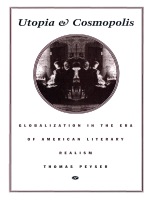 Utopia and Cosmopolis: Globalization in the Era of American Literary Realism
Thomas Peyser
Duke University Press, 1998 When did Americans first believe they were at the center of a truly global culture? How did they envision that culture and how much do recent attitudes toward globalization owe to their often utopian dreams? In Utopia and Cosmopolis Thomas Peyser asks these and other questions, offers a reevaluation of American literature and culture at the dawn of the twentieth century, and provides a new context for understanding contemporary debates about America’s relation to the rest of the world.
Applying current theoretical work on globalization to the writing of authors as diverse as Edward Bellamy, Charlotte Perkins Gilman, William Dean Howells, and Henry James, Peyser reveals the ways in which turn-of-the-century American writers struggled to understand the future in a newly emerging global community. Because the pressures of globalization at once fostered the formation of an American national culture and made national culture less viable as a source of identity, authors grappled to find a form of fiction that could accommodate the contradictions of their condition. Utopia and Cosmopolis unites utopian and realist narratives in subtle, startling ways through an examination of these writers’ aspirations and anxieties. Whether exploring the first vision of a world brought together by the power of consumer culture, or showing how different cultures could be managed when reconceived as specimens in a museum, this book steadily extends the horizons within which late nineteenth- and early twentieth-century American literature and culture can be understood.
Ranging widely over history, politics, philosophy, and literature, Utopia and Cosmopolis is an important contribution to debates about utopian thought, globalization, and American literature.
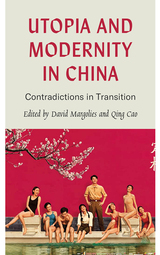 Utopia and Modernity in China: Contradictions in Transition
David Margolies
Pluto Press, 2022 The contradictions of modernization run through the whole of modern Chinese history. The abundance of manufactured goods being sold in the West attests to China's industrial revolution, but this capitalist vision of 'utopia' sits uneasily with traditional Chinese values. It is also in conflict with the socialism that has been the bedrock of Chinese society since the foundation of the People's Republic in 1949.
Utopia and Modernity in China examines the conflicts inherent in China's attempt to achieve a 'utopia' by advancing production and technology. Through the lenses of literature, arts, law, the press and the environment, the contributors interrogate the contradictions of modernization in Chinese society and its fundamental challenges.
By unpicking both China's vision of utopia and its realities and the increasing tension between traditional Chinese values and those of the West, this book offers a unique insight into the cultural forces that are part of reshaping today's China.
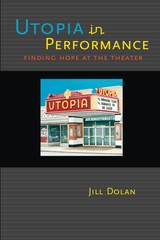 Utopia in Performance: Finding Hope at the Theater
Jill Dolan
University of Michigan Press, 2005 "Jill Dolan is the theatre's most astute critic, and this new book is perhaps her most important. Utopia in Performance argues with eloquence and insight how theatre makes a difference, and in the process demonstrates that scholarship matters, too. It is a book that readers will cherish and hold close as a personal favorite, and that scholars will cite for years to come."
---David Román, University of Southern California
What is it about performance that draws people to sit and listen attentively in a theater, hoping to be moved and provoked, challenged and comforted? In Utopia in Performance, Jill Dolan traces the sense of visceral, emotional, and social connection that we experience at such times, connections that allow us to feel for a moment not what a better world might look like, but what it might feel like, and how that hopeful utopic sentiment might become motivation for social change.
She traces these "utopian performatives" in a range of performances, including the solo performances of feminist artists Holly Hughes, Deb Margolin, and Peggy Shaw; multicharacter solo performances by Lily Tomlin, Danny Hoch, and Anna Deavere Smith; the slam poetry event Def Poetry Jam; The Laramie Project; Blanket, a performance by postmodern choreographer Ann Carlson; Metamorphoses by Mary Zimmerman; and Deborah Warner's production of Medea starring Fiona Shaw. While the book richly captures moments of "feeling utopia" found within specific performances, it also celebrates the broad potential that performance has to provide a forum for being human together; for feeling love, hope, and commonality in particular and historical (rather than universal and transcendent) ways.
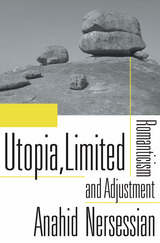 Utopia, Limited: Romanticism and Adjustment
Anahid Nersessian
Harvard University Press, 2015 What is utopia if not a perfect world, impossible to achieve? Anahid Nersessian reveals a basic misunderstanding lurking behind that ideal. In Utopia, Limited she enlists William Blake, William Wordsworth, John Keats, and others to redefine utopianism as a positive investment in limitations. Linking the ecological imperative to live within our means to the aesthetic philosophy of the Romantic period, Nersessian’s theory of utopia promises not an unconditionally perfect world but a better world where we get less than we hoped, but more than we had.
For the Romantic writers, the project of utopia and the project of art were identical. Blake believed that without limits, a work of art would be no more than a set of squiggles on a page, or a string of nonsensical letters and sounds. And without boundaries, utopia is merely an extension of the world as we know it, but blighted by a hunger for having it all. Nersessian proposes that we think about utopia as the Romantics thought about aesthetics—as a way to bind and thereby emancipate human political potential within a finite space.
Grounded in an intellectual tradition that begins with Immanuel Kant and includes Theodor Adorno and Northrop Frye, Utopia, Limited lays out a program of “adjustment” that applies the lessons of art to the rigors of life on an imperiled planet. It is a sincere response to environmental devastation, offering us a road map through a restricted future.
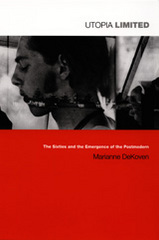 Utopia Limited: The Sixties and the Emergence of the Postmodern
Marianne DeKoven
Duke University Press, 2004 Utopia Limited is an original, engaging account of how postmodernism emerged from the political and cultural upheaval of the 1960s. Marianne DeKoven argues that aspects of sixties radical politics and culture simultaneously embodied the full, final flowering of the modern and the beginning of the postmodern. Analyzing classic sixties texts, DeKoven shows where the utopian master narratives underlying the radical and countercultural movements gave way to the “utopia limited” of the postmodern as a range of competing political values and desires came to the fore. She identifies the pivots where the modern was superseded by the nascent postmodern: where modern mass culture was replaced by postmodern popular culture, modern egalitarianism morphed into postmodern populism, and modern individualism fragmented into postmodern politics and cultures of subjectivity. DeKoven rigorously analyzes a broad array of cultural and political texts important in the sixties—from popular favorites such as William S. Burroughs’s Naked Lunch to political manifestoes including The Port Huron Statement, the founding document of SDS (Students for a Democratic Society). She examines texts that overtly discuss the conflict in Vietnam, Black Power, and second-wave feminism—including Frances FitzGerald’s Fire in the Lake, James Baldwin’s The Fire Next Time, and Shulamith Firestone’s The Dialectic of Sex; experimental pieces such as The Living Theatre’s Paradise Now; influential philosophical works including Roland Barthes’s Mythologies and Herbert Marcuse’s One-Dimensional Man; and explorations of Las Vegas, the prime location of postmodernity. Providing extensive annotated bibliographies on both the sixties and postmodernism, Utopia Limited is an invaluable resource for understanding the impact of that tumultuous decade on the present.
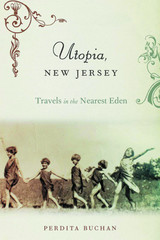 Utopia, New Jersey: Travels in the Nearest Eden
Buchan, Perdita
Rutgers University Press, 2007 Winner of the 2008 Honor Book by the New Jersey Council for the Humanities
Utopia. New Jersey. For most people—even the most satisfied New Jersey residents—these words hardly belong in the same sentence. Yet, unbeknown to many, history shows that the state has been a favorite location for utopian experiments for more than a century. Thanks to its location between New York and Philadelphia and its affordable land, it became an ideal proving ground where philosophical and philanthropical organizations and individuals could test their utopian theories.
In this intriguing look at this little-known side of New Jersey, Perdita Buchan explores eight of these communities. Adopting a wide definition of the term utopia—broadening it to include experimental living arrangements with a variety of missions—Buchan explains that what the founders of each of these colonies had in common was the goal of improving life, at least as they saw it. In every other way, the communities varied greatly, ranging from a cooperative colony in Englewood founded by Upton Sinclair, to an anarchist village in Piscataway centered on an educational experiment, to the fascinating Physical Culture City in Spotswood, where drugs, tobacco, and corsets were banned, but where nudity was widespread. Despite their grand intentions, all but one of the utopias—a single-tax colony in Berkeley Heights—failed to survive. But Buchan shows how each of them left a legacy of much more than the buildings or street names that remain today—legacies that are inspiring, surprising, and often outright quirky.
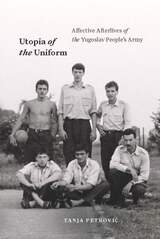 Utopia of the Uniform: Affective Afterlives of the Yugoslav People's Army
Tanja Petrovic
Duke University Press, 2024 The compulsory service for young men in the Yugoslav People’s Army (JNA) created bonds across ethnic, religious, and social lines. These bonds persisted even after the horrific violence of the 1990s, in which many of these men found themselves on opposite sides of the front lines. In Utopia of the Uniform, Tanja Petrović draws on memories and material effects of dozens of JNA conscripts to show how their experience of military service points to futures, forms of collectivity, and relations between the state and the individual different from those that prevailed in the post-Yugoslav reality. Petrović argues that the power of repetitive, ritualized, and performative practices that constituted military service in the JNA provided a framework for drastically different men to live together and befriend each other. While Petrović and her interlocutors do not idealize the JNA, they acknowledge its capacity to create interpersonal relationships and affective bonds that brought the key political ideas of collectivity, solidarity, egalitarianism, education, and comradeship into being.
Utopia: Three Plays for a Postdramatic Theatre
Claire MacDonald
Intellect Books, 2015 A cofounder of the United Kingdom’s legendary 1980s performance company Impact Theatre Co-op, Claire MacDonald composed Utopia, a sequence of commissioned playtexts, between 1987 and 2008. This book brings together both the plays and the story of how they came to be written and produced. With a compelling introduction by the author and including additional material by Tim Etchells, Dee Heddon, and Lenora Champagne, it provides a range of historical and critical materials that put the plays in the context of MacDonald’s career as writer and collaborator and show how visual practices and poetics, theories of real and imagined space, and new approaches to language itself have profoundly shaped the development of performance writing in the United Kingdom.
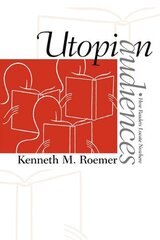 Utopian Audiences: How Readers Locate Nowhere
Kenneth M. Roemer
University of Massachusetts Press, 2009 How do readers transform Utopia? How do they manipulate imaginary worlds to gain new perceptions of their own worlds, perceptions that help them build desires to change reality into a somewhere resembling the author's nowhere? How do authors engage readers in this process? How do cultures, historical forces, and literary conventions create spaces enabling authors to invite and readers to engage? These are questions addressed in Utopian Audiences, the first study to employ a wide spectrum of reader-response approaches to define the nature and impact of utopian literature.
In the first part of the book, Kenneth M. Roemer establishes why utopian literature offers an attractive arena for reader-response criticism. He focuses on the literature's diversity, its provocative and multi-genre character, and the availability of documented responses as different as book illustrations and intentional communities. In the second part, he concentrates on late nineteenth-century America, which witnessed a grand outpouring of utopian literature, and in particular on Edward Bellamy's Looking Backward, the most popular and influential American utopian novel.
The study progresses from broad cultural constructs to specific modern responses; from the perceptual systems and reading conventions allowing readers to "see" utopias to text-based models of implied readers and to documented readings of actual people, including Bellamy himself, reviewers, and 733 late twentieth-century readers. A fictional gathering of all the readers concludes the book.
 Utopian Genderscapes: Rhetorics of Women's Work in the Early Industrial Age
Michelle C. Smith
Southern Illinois University Press, 2021 2022 Winifred Bryan Horner Outstanding Book Award, Honorable Mention!
A necessary rhetorical history of women’s work in utopian communities
Utopian Genderscapes focuses on three prominent yet understudied intentional communities—Brook Farm, Harmony Society, and the Oneida Community—who in response to industrialization experimented with radical social reform in the antebellum United States. Foremost among the avenues of reform was the place and substance of women’s work. Author Michelle C. Smith seeks in the communities’ rhetorics of teleology, choice, and exceptionalism the lived consequences of the communities' lofty goals for women members.
This feminist history captures the utopian reconfiguration of women’s bodies, spaces, objects, and discourses and delivers a needed intervention into how rhetorical gendering interacts with other race and class identities. The attention to each community’s material practices reveals a gendered ecology, which in many ways squared unevenly with utopian claims. Nevertheless, this volume argues that this utopian moment inaugurated many of the norms and practices of labor that continue to structure women’s lives and opportunities today: the rise of the factory, the shift of labor from home spaces to workplaces, the invention of housework, the role of birth control and childcare, the question of wages, and the feminization of particular kinds of labor.
An impressive and diverse array of archival and material research grounds each chapter’s examination of women’s professional, domestic, or reproductive labor in a particular community. Fleeting though they may seem, the practices and lives of those intentional women, Smith argues, pattern contemporary divisions of work along the vibrant and contentious lines of gender, race, and class and stage the continued search for what is possible.
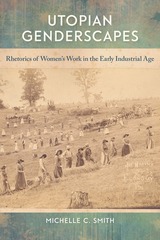 Utopian Genderscapes: Rhetorics of Women’s Work in the Early Industrial Age
Michelle C. Smith
Southern Illinois University Press, 2021 2022 Winifred Bryan Horner Outstanding Book Award, Honorable Mention!
A necessary rhetorical history of women’s work in utopian communities
Utopian Genderscapes focuses on three prominent yet understudied intentional communities—Brook Farm, Harmony Society, and the Oneida Community—who in response to industrialization experimented with radical social reform in the antebellum United States. Foremost among the avenues of reform was the place and substance of women’s work. Author Michelle C. Smith seeks in the communities’ rhetorics of teleology, choice, and exceptionalism the lived consequences of the communities' lofty goals for women members.
This feminist history captures the utopian reconfiguration of women’s bodies, spaces, objects, and discourses and delivers a needed intervention into how rhetorical gendering interacts with other race and class identities. The attention to each community’s material practices reveals a gendered ecology, which in many ways squared unevenly with utopian claims. Nevertheless, this volume argues that this utopian moment inaugurated many of the norms and practices of labor that continue to structure women’s lives and opportunities today: the rise of the factory, the shift of labor from home spaces to workplaces, the invention of housework, the role of birth control and childcare, the question of wages, and the feminization of particular kinds of labor.
An impressive and diverse array of archival and material research grounds each chapter’s examination of women’s professional, domestic, or reproductive labor in a particular community. Fleeting though they may seem, the practices and lives of those intentional women, Smith argues, pattern contemporary divisions of work along the vibrant and contentious lines of gender, race, and class and stage the continued search for what is possible.
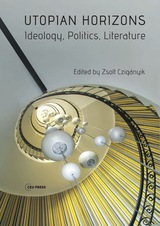 Utopian Horizons: Ideology, Politics, Literature
Zsolt Cziganyik
Central European University Press, 2017 The 500th anniversary of Thomas More’s Utopia has directed attention toward the importance of utopianism. This book investigates the possibilities of cooperation between the humanities and the social sciences in the analysis of 20th century and contemporary utopian phenomena. The papers deal with major problems of interpreting utopias, the relationship of utopia and ideology, and the highly problematic issue as to whether utopia necessarily leads to dystopia. Besides reflecting the interdisciplinary nature of contemporary utopian investigations, the eleven essays effectively represent the constructive attitudes of utopian thought, a feature that not only defines late 20th- and 21st-century utopianism, but is one of the primary reasons behind the rising importance of the topic. The volume’s originality and value lies not only in the innovative theoretical approaches proposed, but also in the practical application of the concept of utopia to a variety of phenomena which have been neglected in the utopian studies paradigm, especially to the rarely discussed Central European texts and ideologies.
The Utopian Nexus in Don Quixote
Myriam Yvonne Jehenson
Vanderbilt University Press, 2006 Jehenson and Dunn explore the mythic utopian desires that drive Don Quixote and Sancho Panza in Don Quixote. By tracing the discourses surrounding what they identify as a myth of abundance and a myth of "simple wants" throughout Spain and the rest of Europe at the time, Jehenson and Dunn are able to contextualize some of the stranger incidents in Don Quixote, including Camacho's wedding. They bring to the forefront three aspects of the novel: the cultural and juridical background of Don Quixote's utopian program for reviving the original property-less condition of the Age of Gold; the importance for Sancho Panza of the myths of Cockaigne and Jauja; and the author's progressive skepticism about utopian programs.
The Utopian Novel in America, 1886–1896: The Politics of Form
Jean Pfaelzer
University of Pittsburgh Press, 1989 In the late 1800s, Americans flocked to cities, immigration, slums, and unemployment burgeoned, and America's role in foreign affairs grew. This period also spawned a number of fictional glimpses into the future. After the publication of Edward Bellamy's Looking Backward in 1888, there was an outpouring of utopian fantasy, many of which promoted socialism, while others presented refined versions of capitalism. Jean Pfaelzer's study traces the impact of the utopian novel and the narrative structures of these sentimental romances. She discusses progressive, pastoral, feminist, and apocalyptic utopias, as well as the genre's parodic counterpart, the dystopia.
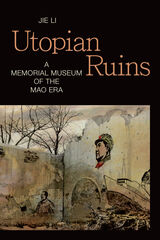 Utopian Ruins: A Memorial Museum of the Mao Era
Jie Li
Duke University Press, 2020 In Utopian Ruins Jie Li traces the creation, preservation, and elision of memories about China's Mao era by envisioning a virtual museum that reckons with both its utopian yearnings and its cataclysmic reverberations. Li proposes a critical framework for understanding the documentation and transmission of the socialist past that mediates between nostalgia and trauma, anticipation and retrospection, propaganda and testimony. Assembling each chapter like a memorial exhibit, Li explores how corporeal traces, archival documents, camera images, and material relics serve as commemorative media. Prison writings and police files reveal the infrastructure of state surveillance and testify to revolutionary ideals and violence, victimhood and complicity. Photojournalism from the Great Leap Forward and documentaries from the Cultural Revolution promoted faith in communist miracles while excluding darker realities, whereas Mao memorabilia collections, factory ruins, and memorials at trauma sites remind audiences of the Chinese Revolution's unrealized dreams and staggering losses.
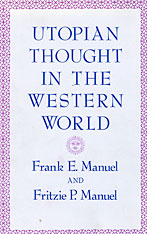 Utopian Thought in the Western World
Frank E. Manuel and Fritzie P. Manuel
Harvard University Press, 1979 This masterly study has a grand sweep. It ranges over centuries, with a long look backward over several millennia. Yet the history it unfolds is primarily the story of individuals: thinkers and dreamers who envisaged an ideal social order and described it persuasively, leaving a mark on their own and later times.
The roster of utopians includes men of all stripes in different countries and eras--figures as disparate as More and Fourier, the Marquis de Sade and Edward Bellamy, Rousseau and Marx. Fascinating character studies of the major figures are among the delights of the book.
Utopian writings run the gamut from fictional narratives to theoretical treatises, from political manifestos to constitutions for a new society. The Manuels have structured five centuries of utopian invention by identifying successive constellations, groups of thinkers joined by common social and moral concerns. Within this framework they analyze individual writings, in the context of the author's life and of the socio-economic, religious, and political exigencies of his time. Concentrating on innovative works, they highlight disjunctures as well as continuities in utopian thought from the Renaissance through the twentieth century.
Witty and erudite, challenging in its interpretations and provocative in the questions it poses, the Manuels' anatomy of utopia is an adventure in ideas.
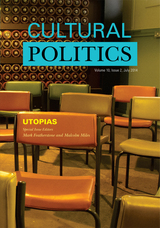 Utopias
Mark Featherstone and Malcolm Miles
Duke University Press Following the collapse of communist and socialist utopianism in the twentieth century, the global economic crisis has foreclosed the promise of a neoliberal consumerist utopia in the twenty first. This issue considers what happens when people believe that the system they currently inhabit does not work, but they see few viable alternatives, and wide-scale change seems impossible in any case. Considering history, fiction, art, and economic theory, the contributors think about the ways in which a vital future might emerge from an exhausted culture. Topics include narratives of catastrophe and escape in Cold War fiction, the narcotic haze of amusement culture in China, an interview with autonomist Paolo Virno on social individualism and imagination, and the meaning of protest and utopian critique in contemporary art. These essays seize a critical opportunity for new forms of cultural politics to emerge. The contributors explore how the current dystopian worldview points toward alternative utopian futures.
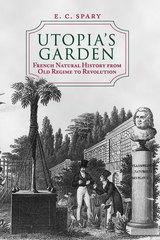 Utopia's Garden: French Natural History from Old Regime to Revolution
E. C. Spary
University of Chicago Press, 2000 The royal Parisian botanical garden, the Jardin du Roi, was a jewel in the crown of the French Old Regime, praised by both rulers and scientific practitioners. Yet unlike many such institutions, the Jardin not only survived the French Revolution but by 1800 had become the world's leading public establishment of natural history: the Muséum d'Histoire Naturelle.
E. C. Spary traces the scientific, administrative, and political strategies that enabled the foundation of the Muséum, arguing that agriculture and animal breeding rank alongside classification and collections in explaining why natural history was important for French rulers. But the Muséum's success was also a consequence of its employees' Revolutionary rhetoric: by displaying the natural order, they suggested, the institution could assist in fashioning a self-educating, self-policing Republican people. Natural history was presented as an indispensable source of national prosperity and individual virtue.
Spary's fascinating account opens a new chapter in the history of France, science, and the Enlightenment.
 Utopia’s Ghost: Architecture and Postmodernism, Again
Reinhold Martin
University of Minnesota Press, 2010 Architectural postmodernism had a significant impact on the broader development of postmodern thought: Utopia’s Ghost is a critical reconsideration of their relationship. Combining discourse analysis, historical reconstruction, and close readings of buildings, projects, and texts from the 1970s and 1980s, Reinhold Martin argues that retheorizing postmodern architecture gives us new insights into cultural postmodernism and its aftermath. Much of today’s discussion has turned to the recovery of modernity, but Martin writes in the Introduction, “Simply to historicize postmodernism seems inadequate and, in many ways, premature.” Utopia’s Ghost connects architecture to current debates on biopolitics, neoliberalism, and corporate globalization as they are haunted by the problem of utopia. Exploring a series of concepts—territory, history, language, image, materiality, subjectivity, and architecture itself—Martin shows how they reorganize the cultural imaginary and shape a contemporary biopolitics that ultimately precludes utopian thought. Written at the intersection of culture, politics, and the city, particularly in the context of corporate globalization, Utopia’s Ghost challenges dominant theoretical paradigms and opens new avenues for architectural scholarship and cultural analysis.
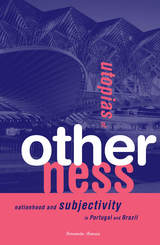 Utopias Of Otherness: Nationhood And Subjectivity In Portugal And Brazil
Fernando Arenas
University of Minnesota Press, 2003 Forges a new understanding of how these two Lusophone nations are connected The closely entwined histories of Portugal and Brazil remain key references for understanding developments—past and present—in either country. Accordingly, Fernando Arenas considers Portugal and Brazil in relation to one another in this exploration of changing definitions of nationhood, subjectivity, and utopias in both cultures. Examining the two nations’s shared language and histories as well as their cultural, social, and political points of divergence, Arenas pursues these definitive changes through the realms of literature, intellectual thought, popular culture, and political discourse. Both Brazil and Portugal are subject to the economic, political, and cultural forces of postmodern globalization. Arenas analyzes responses to these trends in contemporary writers including José Saramago, Caio Fernando Abreu, Maria Isabel Barreno, Vergílio Ferreira, Clarice Lispector, and Maria Gabriela Llansol. Ultimately, Utopias of Otherness shows how these writers have redefined the concept of nationhood, not only through their investment in utopian or emancipatory causes such as Marxist revolution, women’s liberation, or sexual revolution, but also by shifting their attention to alternative modes of conceiving the ethical and political realms.
 Utpaladeva on the Power of Action: A First Edition, Annotated Translation and Study of Īśvarapratyabhijñāvivṛti, Chapter 2.1
Isabelle Ratié
Harvard University Press The Recognition of the Lord (Īśvarapratyabhijñā) by the Kashmirian Utpaladeva (c. 925–975) is a landmark in the history of nondual Śaivism, and one of the masterpieces of Indian philosophy. The detailed commentary (Vivṛti) on it by the author himself was so far considered almost entirely lost, but three chapters of this major work were recently recovered from marginal annotations in manuscripts of other commentaries on Utpaladeva’s treatise. The book provides the first critical edition, annotated translation and study of one of these chapters, which endeavours to justify a fundamental paradox of the system—namely, the idea that Śiva (understood as an infinite, omniscient, and omnipotent consciousness) has a dynamic essence since the core of consciousness is a subtle form of action, and yet is by no means limited by the temporal and spatial sequence that affects all ordinary acts and agents.
 Utrecht University and Colonial Knowledge: Exploration, Exploitation and the Civilising Mission since 1636
Henk van Rinsum
Amsterdam University Press, 2025 In this book, Henk van Rinsum provides an in-depth description of the colonial past of Utrecht University in the Netherlands, from its foundation in 1636. He describes the development of (scientific) knowledge and knowledge transfer about and in the Dutch colonies, especially in the Dutch East Indies. The central theme of his book is the idea of Western superiority – the assumption that we are ‘developed’ and therefore modern, while those in the colonies are ‘not (yet) developed’ and therefore primitive or traditional. This colonial past is also the framework in which Utrecht University became involved in slavery and its abolition.
Henk van Rinsum shows how the knowledge acquired in the colony also contributed significantly to the scientific development of the university, especially towards the end of the nineteenth century. Utrecht University and Colonial Knowledge is therefore an important contribution to both colonial and intellectual history.
 Utter Antiquity: Perceptions of Prehistory in Renaissance England
Arthur B. Ferguson
Duke University Press, 1993 Historians know a great deal about how English thinkers of the sixteenth and seventeenth centuries saw the "documentable" past, but relatively little about how they perceived times stretching back beyond history. Arthur B. Ferguson shows in this elegant essay that prehistory had great meaning in Renaissance England. Commentators of various sorts—from poets to antiquaries—looked to the most distant past for the vanishing point that would perfect their historical perspective and orient them in an age of increasing change. In this pursuit they had often to let imagination serve the purposes of interpretation. Though largely speculative, their efforts reveal much about the intellectual life of Renaissance England.
Since the Bible left little room for speculation on prehistory—in fact no room at all for the concept itself—Utter Antiquity concentrates on myth and legend outside of the biblical context and on those who conjured prehistory out of these sources. A subtle conflict between belief and skepticism emerges from these pages, as Ferguson reveals how some Renaissance writers struggled with ancient explanations that flouted reason and experience, while others sidestepped such doubts by relating prehistory to man's social evolution. By isolating and analyzing topics such as skepticism, rationalism, and poetic history, Ferguson illuminates the development of historical consciousness in early modern England. His accessible and eloquent study contributes significantly to an understanding of the Renaissance mind and intellectual history in general.
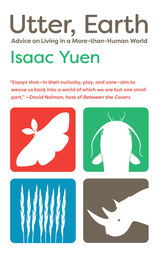 Utter, Earth: Advice on Living in a More-than-Human World
Isaac Yuen
West Virginia University Press, 2024 Part nature guide, part self-help column, and all love letter to the more-than-human world, Utter, Earth is an exercise in wonder. For animal lovers and readers of Brian Doyle, Aimee Nezhukumatathil, and Amy Leach.
A light, literary take on an animal book for grown-ups, a tongue-in-cheek self-help column with lessons drawn from nature, a sort of hitchhiker’s guide to the more-than-human world—Isaac Yuen’s Utter, Earth is a celebration, through wordplay and earthplay, of our planet’s riotous wonders.
In a time of dirges and elegies for the natural world, Utter, Earth features odes to sloths, tributes to trilobites, and ringing endorsements for lichen. For animal lovers and readers of Brian Doyle, Aimee Nezhukumatathil, and Amy Leach, each essay of this one-of-a-kind collection combines joyous language, whimsical tangents, and scientific findings to remind us of and reconnect us with those to whom we are inextricably bound. Highlighting life that once was, still is, and all that we stand to lose, this living and lively mini encyclopedia (complete with glossary) shines the spotlight on the motley, fantastical, and astonishing denizens with whom we share this planet.
|
|
